#lesser-known Hong Kong
Explore tagged Tumblr posts
Text
Hong Kong Secrets: Uncover The Top 10 Must-Visit Hidden Gems
#best kept secrets Hong Kong#Big Wave Bay#Blade Street in Sheung Wan#cultural spots in Hong Kong#discover Hong Kong#explore Hong Kong#hidden attractions Hong Kong#hidden Hong Kong#Hoi Ha Wan Marine Park#Hong Kong adventure#Hong Kong exploration#Hong Kong hidden gems#Hong Kong local experiences#Hong Kong secret locations#Hong Kong travel guide#Hong Kong unusual attractions#Kowloon Walled City Park#lesser-known Hong Kong#Museum of Medical Sciences#off the beaten path Hong Kong#Ozone Bar#Peng Chau Island#quiet spots in Hong Kong#secret Hong Kong travel#secret spots in Hong Kong#Sun Yat Sen Memorial Park#Tai Long Wan#Ten Thousand Buddhas Monastery#unique places in Hong Kong#Yuen Po Street Bird Garden
1 note
·
View note
Text
Shui Long Yin 《水龙吟》 - What we know so far about this massive project
By now many of you have heard about Shui Long Yin 《水龙吟》, Luo Yunxi's upcoming and third project with the studio behind Till the End of the Moon. Here's my read on the announcement earlier.
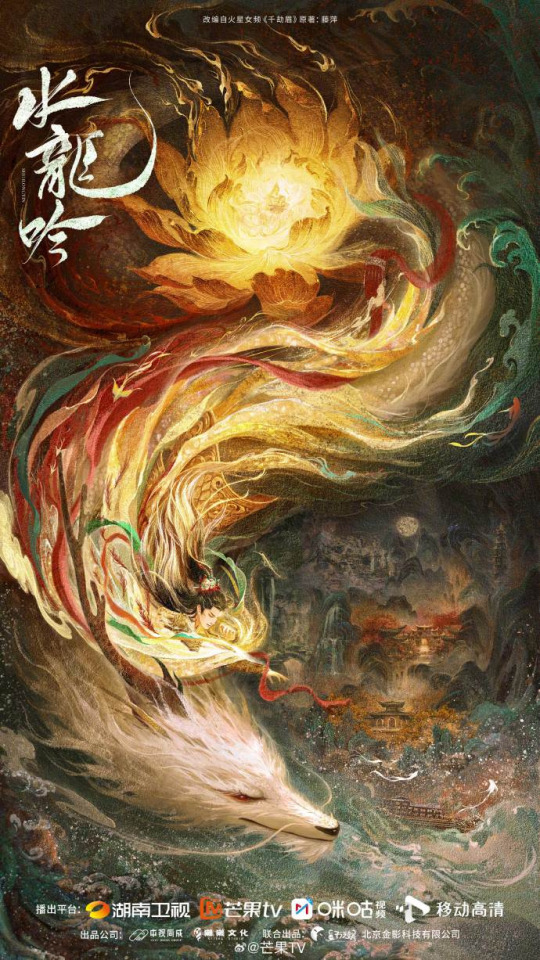
1. Good news - It's going to be largely the same creative team behind TTEOTM.
You have Wang Yirong as Lead Producer & Artistic Director, Huang Wei as Costume Designer, Wang Haiqi as Action Director, Tsang Mingfai as Makeup Director, Huatian for World Concept (also known for Ashes of Love and the Untamed). Basically, we'll see the return of the brilliant minds behind the Dunhuang-inspired costumes and hour-long epic fight sequences.
It's a good sign they're holding most of the team together. A lot of great directors, like Christopher Nolan, Tim Burton, David Cronenberg, work with the same creative talent over and over again. There's certainly an argument that you produce better work when you collaborate with people you trust and know well.
2. Up and coming Director Chen Zhoufei will make up some of the deficiencies of TTEOTM in the cinematography and lighting departments.
Chen Zhoufei started out as a cinematographer in films with the likes of Chen Kaige and Zhang Yimou. More recently he directed The Forbidden Flower (2023) and Double Tap (2021), which, if nothing else, is beautifully and stylistically shot.

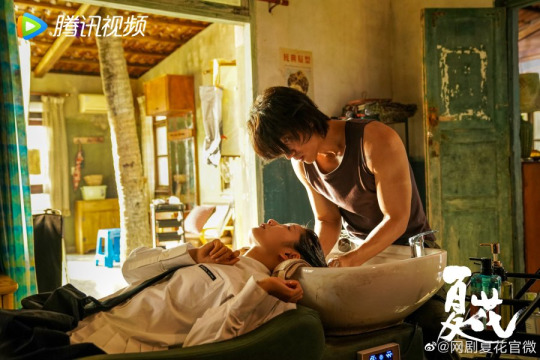
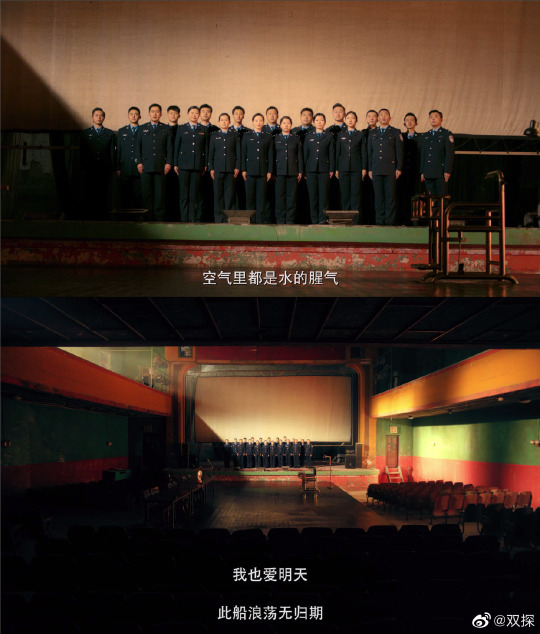
It's interesting they've moved away from the old school Hong Kong directors they used in Immortality and TTEOTM. Directors from the TVB system are known to be more experienced, scrappy, and reliable when it comes to working within budget (which is why they're favored for big xianxia productions), but they've also been criticized for falling behind on technical execution and artistry.
It is as the industry article I shared predicted - Otters Studio is a relatively inexperienced player, but they can quickly close their gaps by bringing new blood to the team.
3. They're bringing a new Art Director, Zheng Chen from Lost You Forever.
This isn't all that surprising given that Luan Hexin, TTEOTM's Art Director, is with Huanyu, Bai Lu's management company. (In fact there was a bit of real life drama when Yu Zheng, Bai Lu's boss, publicly called out TTEOTM's producer for not refuting false rumors that Bai Lu was only cast because the production wanted Luan Hexin, arguably Huanyu's biggest asset, as part of her "dowry".) Now it's sad to see award-winning Luan go, but he is best for authentic period sets and IMO not the most suited for xianxias.
Instead, they've tapped Zheng Chen, who most recently worked on Lost You Forever, which I have yet to watch. With that said, some of the sets look great to me, with bold use of colors, and I can already see this pairing well with Chen Zhoufei's aesthetics.
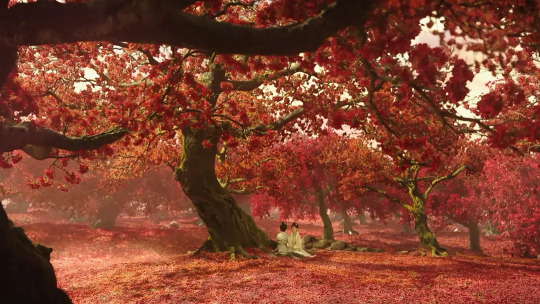
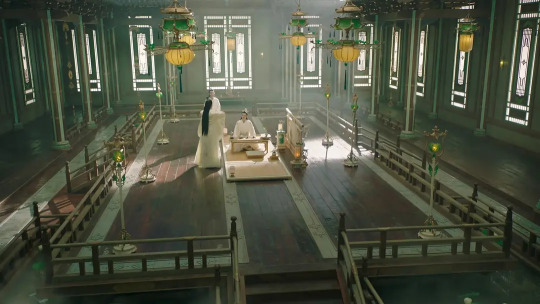
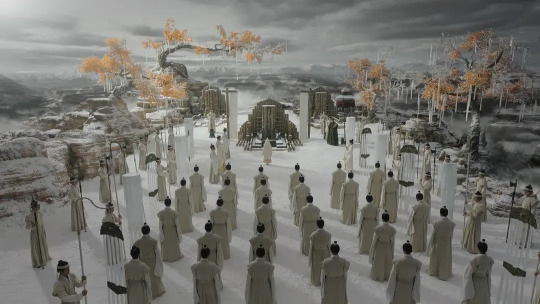
4. This time they're not working with screenwriter He Fang, instead going with Lin Conghe (unofficial)
He Fang is the lead screenwriter behind TTEOTM and Immortality (everyone who's read Immortality's screenplay will know it's all but a guaranteed hit) and in my opinion one of Otter's greatest assets. She's brilliant at staying loyal to the spiritual core of source novels, while weaving convoluted plot points through a more robust background story and logic.
It's a slight disappointment that she won't be back, but it's also not entirely surprising. TTEOTM and Immortality are both big, female-oriented fantasy romance IPs. Meanwhile Shui Long Yin's IP is quite dated, lesser known, and incomplete, so I'd expect that the drama will only be loosely based on the original. While we don't know much about Lin Conghe, he did recently work on the Blood of Youth sequel, where he was the lead screenwriter alongside author Zhou Munan, so he might actually be a better choice for this genre (xuanhuan wuxia).
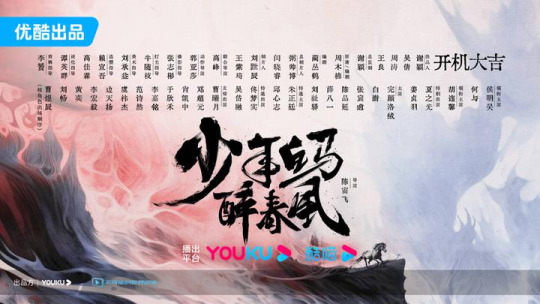
5. The way HunanTV & Mango announced the drama is unusually high profile, indicating that this is one of the platform's biggest projects.
It's rare to have one of China's biggest hosts announce a new drama that hasn't even started shooting or released any details yet live on prime time TV. (Usually a drama's official announcement comes out on the day of its booting ceremony, if not during its production or at its wrap ceremony.) It's even rarer for a costume drama to announce a TV platform at this stage. These days it's quite difficult for costume fantasies to get a coveted TV airing slot given genre restrictions and additional censorship requirements. Typically you do not find out officially whether it will air on TV until literally right before it airs.
Before the official announcement, rumors have already been circulating that there's a bidding war behind the scenes for this project, with Mango and its parent HunanTV outbidding Youku in the end. Mango/HunanTV is already the market leader in variety shows, but is behind the other three platforms in scripted content. Apparently, they've recently received an injection of funding to shore up their drama department and now investing in tentpole projects that can help them gain share. Clearly they saw what TTEOTM did for Youku.
6. There's another interesting player in the mix: China Mobile and its subsidiary Migu.

It appears that China Mobile (one of the most valuable companies in China and a state-owned enterprise) has invested in the drama, which will be made available on its online video platforms. Apparently, the last time China Mobile invested in a drama, they sent text messages to every user to publicize it when it aired. Now not sure if this will happen (it's not patriotic drama after all), but they've already been promoting the drama through their gazillion affiliate social media accounts. Either way, it should be a good thing for the drama's distribution to have such an influential backer given Mango's lower daily active user.
7. They're making it super clear that Luo Yunxi is going to be the dominant male lead in this drama
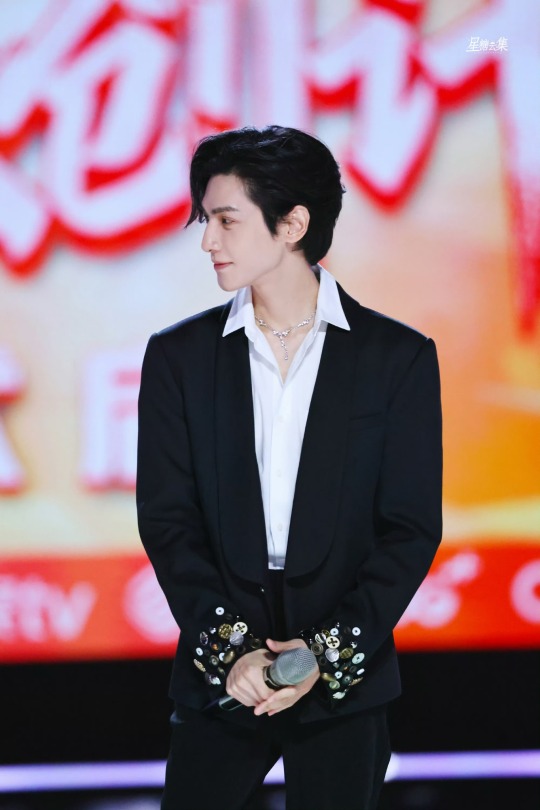

In the first Weibo post, they only announced the title, Luo Yunxi, and the airing platforms. In the second Weibo post, where they announced the rest of the creative team, they still did not announce the other actors! Of course, this is likely because Luo Yunxi's company (which is really just him) bought the source novel's IP and is credited as a co-producer. (They don’t have any production capabilities at all, so Otter will likely be quarterbacking this.)
This suggests, like many who have read the novel already know, that Luo Yunxi will have by far the biggest part. The other roles, including the female lead role, will likely be smaller and revolve around the main character.
8. Shui Long Yin is already generating a lot of hype.
To date its Weibo announcement racked up >1M likes (more than double that of TTEOTM). There's already a very active Douban group debating all the rumors, most importantly whether Luo Yunxi will use a wig or his real hair (a highly divisive topic). The new drama has even been reported by China Daily, China's state media facing the international community, which is again exceedingly rare. China Daily doesn't usually report on entertainment news, and most hit shows don't get mentioned even after airing.
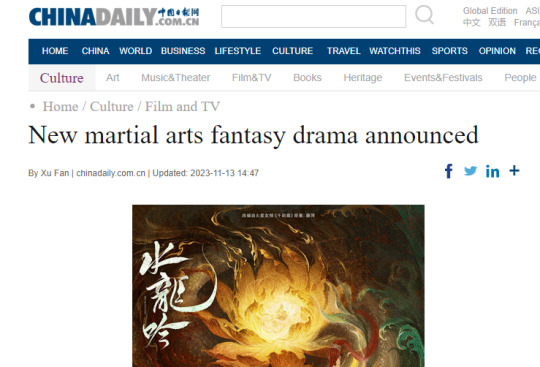
There's always a big risk with productions with this much anticipation so early in the process, from fan wars and disruptive stalking on set to accusations propagated by competitors that can invite more state scrutiny. Fingers crossed that the team knows what they're doing and can weather all the storms that will undoubtedly come its way.
9. Finally, I remain cautiously excited.
Production quality will likely be great, with such a strong creative team and financial backers with deep wallets. My main worry is that it'll be beautiful, but boring. For this genre (xuanhuan wuxia or basically wuxia with high fantasy elements), it's really important that the story moves fast and the underdog hero keeps outsmarting or outfighting everyone else in a way that gives viewers a sense of exhilaration. It'd be all too easy for the story to get bogged down by a large cast of unmemorable characters and a meandering plot. Otters Studio is usually great at delivering fast-paced high drama (just based on TTEOTM and the screenplay of Immortality), but they're working with a different screenwriter this time and it's not easy to be a consistent hit maker. Let's hope they stick to their intuition and continue to present stories and characters that excite viewers.
#luo yunxi#till the end of the moon#cdrama#black moonlight holds the be script#tteotm#chinese drama#shui long yin#otters studio
80 notes
·
View notes
Text
2024 Year in Review
(This is a public post, and is also available on Patreon!)

Wow! What a year. Compared to last year, a lot more things definitely happened, including several core videos I'm very proud of, the launch of Useless Nintendo Trivia videos, and the main channel finally passing the 50,000 subscriber mark! This has been one of the best years for the channel in a while, and I'm very thankful for all the support and feedback.
Outside the channel, my Bluesky account created in 2023 has passed 10k followers, I talked about WarioWare with Scott the Woz for an hour, and lots of very neat things happened in real life for me as well! I was able to switch day jobs in December and work with a company in the retro gaming space which is very exciting, and I visited America, met some of my friends there and attended the Portland Retro Gaming Expo for the very first time! So overall, a very eventful year, and I'm definitely excited to both look back on the stuff I've made, and give some hints about what's next!
You know the drill by now, I'm going to be sharing my retrospective thoughts as well as some fun facts about every video I've made on the main channel during 2024!
The Joy of Nintendo DSi/3DS Camera & Sound

This video idea was the winner of a Patreon poll back in June 2023...and yeah, ended up releasing in January 2024, but that meant it made for a pretty fantastic start to the new year! After talking about previous camera-related offerings from Nintendo like the Game Boy Camera and Photo Dojo, it only seemed natural to talk about the built-in camera and music apps for the DSi and 3DS, and I think it hit a great balance between being informative about the lesser-known aspects of these apps, and also having some decent gags! I even ended up upgrading my 3DS capture card from an old 2DS to a New 3DS XL during the production, just because I had to showcase the 3D mode-exclusive camera features. So far, it's served me incredibly well! I can absolutely vouch for the quality of Loopy's stuff now.
Some folks were wondering I managed to capture footage of the DSi camera and sound apps, the truth is...I kinda lied and that footage was captured on my New 3DS XL capture card! Yes, you can install and run DSi Camera and DSi Sound on a 3DS.
I'd like to once again give a shoutout to ThattsCherry (who also did the animation for my latest intro), who drew two animated shots featuring stylized Nintendo employees! Her style lent incredibly well to these sorts of visuals, though I did accidentally overlook a mistake where there was a 3DS logo in the background of a shot...about the DSi camera. (Oops) I also want to shout out TikaratheMew as well for the fantastic parakeet thumbnail art! (She also did the thumbnail art for my Famicom R.O.B. the Robot video as well!) I posted this sketch/final comparison on social media previously, but here it is again for posterity:

And finally, just a random fact: the brief gag featuring the 'retro-inspired indie game' actually comes from a university programming assignment I did years ago, but reskinned with generic pixel art as the original just used 8-bit sprites from Super Mario Bros.! (It also ran way faster than it was supposed to because it was originally programmed on a Windows virtual machine running on a Mac...so yeah.)
I Went to Hong Kong's Nintendo Live & Pop-Up Store

This video was a great opportunity to document two Nintendo events that were basically happening in Hong Kong back-to-back, and I hope it was useful for those who weren't able to attend these events, or those who want to know more about Nintendo's international events! I still hope these events are successful enough to warrant future large-scale Nintendo events in Hong Kong (which I am totally down to also document), but we haven't had further confirmations outside of a few series-specific promotional events now and then. Here's hoping!
Since this video, more Nintendo Pop-Up Stores have opened in places like Taipei, Seoul and Singapore, with the latest one being part of a manga convention in Barcelona! Seems like they've been doing pretty well, and makes me wonder if they'll ever revisit places for a second round!
Though aside from these pop-up stores, there are still plenty of officially authorized partner stores in Hong Kong that sell both Nintendo products and merch! A very neat one that opened recently was 'Assemble' in Wan Chai, which not only had Nintendo merch (including new stock for the Super Famicom Mini for some reason?), but had dedicated merch areas for third-party partners like Sega, Namco and Square Enix, and even had demo stations for indie games and Arcade Archives releases!

A Cartridge for Nintendo's Lost Devkit

In terms of obscure Nintendo stuff that has been talked about on this channel, the Game Processor RAM Casette is definitely way up there! While these carts (and the Game Processor in general) have been known to exist for a while, and this is also not even the first YouTube video about the Game Processor RAM Casette (Circuit Rewind was ahead of me and figured out how to reprogram one using a Raspberry Pi!), I'm still glad this video was able to get more eyeballs on this little known piece of Nintendo history, and perhaps the dream of finding the Game Processor isn't dead yet! (Hey, if the largest Sony CRT ever made could be found, anything's possible.)
One thing I actually didn't touch on in this video is the packaging that the Game Processor RAM Casettes originally came in! And with a few more auction listings popping up online since that video, I can now show you that...they're basically completely blank Super Famicom game boxes. That's kinda funny.

I mentioned that one of the assets for a Mario Bros.-style game created with the Game Processor's editing tool 'Mario Factory' was later reused for the Mario Bros. minigame in the Super Mario Advance series. While we do have an image proof of this from a flyer scan, I didn't show it in the actual video as the original Japanese accounts that posted these images seem to be a little strict regarding reposting of their work, and I'd like to respect their wishes if possible. With that said, I can now link to those original tweets here, if you haven't taken a look!


How Many Times Have I Paid For Super Mario Bros.?

For Mario Day this year, I decided to just do a scripted video about a ridiculous Mario topic, and since I already had a spreadsheet lying around that kept track of every legal copy of Super Mario Bros. I own, this video was the result, and it ended up as silly as I envisioned it to be. Perhaps Mario Day videos can be another fun annual tradition, though I haven't thought of any ideas for this year's right now. (I mean, I could talk about all my copies of Mario 64 like I teased last time...but that's probably a better fit for the Plus channel!)
The obligatory question is, have I obtained any new copies of Super Mario Bros. since this video was published? The answer is yes: I obtained a loose cartridge of Super Mario Bros. + Duck Hunt + World Class Track Meet on the NES, Super Mario All-Stars + Super Mario World on the SNES, and a US copy of Super Mario All-Stars Limited Edition on the Wii! The count continues.
Those with keen ears may have noticed that the endslate theme in this video is an arrangement of the 'Every Day is a Mario Day' commercial jingle! I asked Megan, the composer of my endslate theme, to give it a little remix for the occasion, and it turned out so well, I definitely have to use it more than once now lol
Useless Nintendo Trivia #1-5

This year marked the start of the 'Useless Nintendo Trivia' series, each installment containing 10 useless Nintendo facts, inspired by my 2023 April Fools video. This was conceived as a relatively simple but fun series of videos that I can put out in-between the major productions, and so far we've covered 50 whole pieces of useless Nintendo trivia! I'm very happy about how this series has been received, so...yeah, more episodes will definitely be on the way! When we reach 100 pieces of trivia, it might be fun to do a compilation of them to see how long they would be when put together!
You might've also seen that some pieces of trivia have also been uploaded to the channel as YouTube shorts. I think this is basically the best way to utilize the shorts format going forward, rather than focusing on making exclusive stuff for it, and if one of the shorts does end up blowing up, it'll still be a nice bonus!
Every Nintendo Stylus

And here's 2024's April Fools video...which if I recall correctly, was another spontaneous idea! I originally talked about Nintendo styluses as an unscripted video on Akfamilyhome Plus, one of the first unscripted videos on that channel in fact, but that video actually left out a few styluses that I didn't have on hand at the time, so I figured if I were to revisit the topic, it would be in the form of a scripted video to cut down on the babbling, and possibly as part of the April Fools series (just because of how ridiculous the topic is). This video blowing up in views is something I can't exactly say I anticipated, but I guess joke topics just do that sometimes...
I made a joke in the video about if anyone ever used the original 3DS stylus by just extending it halfway, so allow me to showcase this incredible reply comment:

When I was looking for accurate stylus terminology for this video, I was made privy to a patent-related rabbit hole that eventually culminated into a piece of useless Nintendo trivia! I'll just link you to the short version here if you haven't seen it yet.
The 34 Games I Beat in 2023

The 2023 game review video ended up coming out in late April because of the Mario Day and April Fools videos (...which may end up being the same case for this year if I can't get it out by February, oops), but this time around it did perform a little better than my 2022 video! It's still neat to have a time capsule of sorts about my immediate thoughts about each game I've finished, and the unpredictable lineup still makes it a fun watch for some. Just to look ahead, 2024's game lineup will be a little shorter at 25 games, but there will be a bonus section or two here and there!
Not much else to add here for this video, but if you look in the description, I have a link to a spreadsheet that compiles an alphabetical list of every game I've looked at in this series of videos, for those who want to look up my quick thoughts about a particular game!
Nintendo's Hotel SNES: The Super Famicom Box

It seems like pretty much every Things of Interest episode released in 2024 was a result of spontaneous new finds and additions to my collection, and the Super Famicom Box was certainly no exception. There have been several YouTube videos that show off the system before, but there haven't been as many scripted videos that also dive into its deeper functionality, so that's sort of what the aim of my video was, to showcase how it would be to set the whole thing up and go through its many settings for the folks (a.k.a. most people) who don't have one, and also offer a simple point of reference for those who do end up getting their hands on one. Really, the only thing I haven't done in the video is basically take the system apart -- there are people out there who are way more qualified to do that!
I've shared the following links in one of my monthly Patreon reports, but for those who haven't seen them, here's a few more interesting videos related to the Super Famicom Box that are worth checking out:
Long Island Retro Gaming has done a mod adding RGB to the system -- and with some results you may not have expected!
Some of their footage was used in my video, but Impendo64 has both added a custom coin slot to their unit, but has also apparently modified one of the game cartridges to add custom games onto it! I hope they make another video showing how they did it in the future!
This is about the original FamicomBox and not the SFC variant, but Yukki games came across a few working FamicomBoxes still doing their jobs in a small Japanese hot spring inn, if you'd like to take in the vibes!
64DD on a Flashcart: The SummerCart64

The Things of Interest video about the SummerCart64 is one of the few unscripted videos on the main channel, where I basically take a look at a thing by just...casually using it and showing off its features! That felt like the best format to show off this flashcart in particular, especially because 64DD support was the one interesting part about it. I did get the price of the Phenom Mod version of the cart a little wrong in the video (I misquoted the PCB price instead of the fully assembled one with shells), but in the end it was still neat to get some more eyeballs on this project, and a few new developments have been made since that video as well!
Since the video, the N64 Flashcart Menu has seen several updates that addressed some of my previous (minor) complaints: there's now a functional settings menu within the interface, and most recently a favorites and history tab have been implemented!
And since Phenom Mod released their version of the SummerCart64 for order, plenty of other cheaper SC64 clones have also started to pop up on the market, particularly ones on Chinese sites like AliExpress. I even got a free product offer from one of the sellers! (but decided against it as it would make for a pretty redundant video) While I can't compare every variety of the SummerCart64 out there, I was eventually able to get my hands on two different AliExpress variants of the SummerCart64. They had pretty different molded shells (one being a tighter fit than the other) and cart connectors, and while in terms of functionality they were fairly similar, making it a viable option for those on a limited budget, they definitely don't have the luxury of the Phenom Mod's more durable build, along with proper support available in the N64brew Discord should any problems arise, so I think there's still some worth in that! This is just my opinion though, it's up to you to decide which SC64 variant you want to go for for your own purposes.
I Broke the Nintendo World Championships Leaderboards

Speaking of spontaneous video ideas, this video definitely was one, being basically born from a stupid Discord conversation while playing the new Nintendo World Championships game. The resulting video is definitely a rare breed for the channel, it's been a hot while since I've done a 'what happens if you do x in y' type of experiment for a video, but it seems people did end up enjoying it!
The week this video went live, I actually tried the same strategy to get on the 2024 Birth Ranking again, and it seems that no one else ended up trying it out for themselves! ...which makes sense, because the setup is way too convoluted. But if there's someone out there still determined to try this trick right now, there's a high chance you'll be able to earn 1st place on the 2024 birth year ranking for yourself! (Or rather, 2025 ranking now lol)
Pyoro: The Bird, The Beans, The Legend

...and finally, this was the next big core video that I was originally intending to make, following the 3DS/DSi Camera & Sound video! As I said in the video itself, this idea came long before the leaker known as Pyoro became a prominent figure, and with the release of WarioWare: Move It, it made for the perfect opportunity to do a Pyoro retrospective with some fun gags sprinkled throughout. And in a first for the channel, this is also the first ever sponsored video on the channel! ...I'll talk about more of my thoughts on that down below in a bit.
If you look at the video thumbnail, all of the Pyoros featured come from a piece of official artwork or in-game sprite...except one, which I drew back in 2021.
Turns out, there were several Pyoro cameos that I forgot to mention: for some reason my mind completely blocked out the fact that Super Pyoro appears in the intro of WarioWare Gold, and there's also a small blink-and-you'll-miss-it Pyoro cameo in WarioWare Move It:
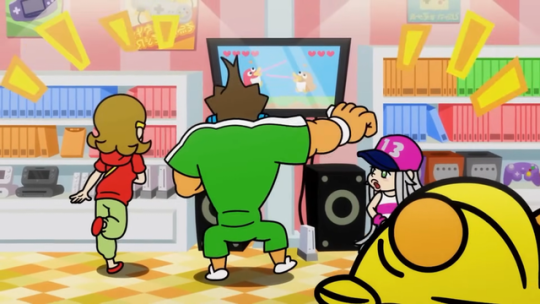
As I said, this is the first video on the channel to be sponsored (by Surfshark)! As taking a sponsor was something I'd never done before, I felt this was a good learning opportunity to do so, and considering how well the video ended up doing, I think Surfshark probably got way more than their money's worth in the end...
Before I ever considered legitimately taking up a sponsor offer, I set several rules for myself: anything I promote must be something I've used in the past and can recommend based on personal experience (if it's something I've never heard of then I would at least do my research and give it a try first), and the sponsor integrations should be made as fun as possible. The Pyoro video was essentially a testing ground for these principles, the idea of integrating the sponsor led to the creation of the VRChat skits, and as a result I think it turned out pretty well! (A post about the sponsor segment itself ending up doing numbers on Twitter, which I think is a good enough indicator lol)
The reason why I took this long to accept any sponsor at all is simply because a lot of offers that come through to my business inbox don't always look the most legit at first glance, especially if it's from a product I've never heard of before. I've also never went through the process of taking a sponsorship myself, and I've heard a few stories of bad sponsors or phishing scams involving fake sponsorships, so I was basically extremely vigilant about them. That being said, this sponsorship was definitely a net positive for me as a learning experience! I don't know if I'll end up taking more sponsors in the future, as it really just depends on the right one stumbling into my inbox that I think I can actually execute properly. And between my inconsistent video schedule and my recent job switch, I don't think I'll have to deliberately seek out sponsors in the near future. I'm feeling content with having this YouTube thing as a side hustle for now, with Patreon support and perhaps the occasional sponsor as bonuses that will potentially push me slowly towards being able to do this full-time in the far future!
And lastly, if you didn't know, some outtakes and animatics for the VRChat skit segments in this video are available to my $5+ patrons!
Nintendo 3DS E3 2010 Demo Showcase

And in time for the new year, another spontaneous video! I originally planned for a Things of Interest episode to release around Christmas or before the end of the year, but while I was working on it, I was contacted by a team working on preserving some 3DS tech demos from a prototype unit in order to make a video documenting them like I did with 3D Challenge back in 2020, and of course I had to say yes!
It was very fun to both help out with research as these demos were being studied, and to write the script for the showcase as well! I think this is one of the best ways to handle a release of this sort: not just hacking the demos so they can be as playable as possible for the public, but also documenting them in a video so detailed info about them is also as easily accessible!
Yes, the ending is a tease for something else 3DS-related to come. Don't know when exactly that will be as research is still being done to put it vaguely, but it's something I personally think is almost as cool!
Akfamilyhome Plus videos

If there's only one thing I regret for this year, it's the smaller amount of content being put out on my second channel Akfamilyhome Plus, because ironically I got busy from all the videos being put on the main channel instead! Still, there are a handful of bonus videos that have been released publicly on there this year:
I gave Alivel Mall from Kirby and the Forgotten Land lyrics for the game's 2nd anniversary
I tried a Gyromite-themed mini board game on a Japanese pencil case from 1985
I talked about how I create YouTube captions from my scripts
I tried the Nintendo Ten Billion Barrel for the first time
...and as mentioned in the beginning, I documented my very first trip to America!
And over on Patreon, 4 exclusive videos were released: I took a look at some third-party Joy-Con, played PC games with an actual Game Boy as a controller, did my annual room tour for 2024 and built a Famicom made out of cardboard!
Alright, what's next
Okay, so as I just mentioned, I was working on a Things of Interest episode right as I was approached to make the 3DS E3 2010 demo showcase, so right now work will be resuming on that video! And seeing as you've read this far into the post, as a thank you I'll let you in on what it's about...

...it's an original, working Nintendo Ultra Machine from 1967! Just like the Super Famicom Box, while there are videos online that showcase it, there's not a lot of scripted videos that get into the history or nitty gritty details, so I'd like to take this opportunity to showcase one of Gunpei Yokoi's earliest inventions!
In addition to that, there is another Things of Interest subject that I'd like to talk about, Useless Nintendo Trivia will obviously continue with new sporadic episodes, and the next major core video topic has already been decided, though with all these projects in the pipeline, it might be a little bit before that's fully in production!
Overall, I'd like to keep up the momentum this channel picked up in 2024. I was pretty close to my goal of having a video out on the channel every month, save for edge cases where I released a video right as a month ended, or September onwards when I was occupied with my trip to America (and documenting that into a video) among other things! While I have switched jobs in real life, I'm currently hoping it won't affect too much of my video schedule going forward, as working on this channel is something I continue to enjoy immensely, and I'd like to thank you all again for watching in 2024.
So yeah, that's it for this long year in review! Once again, as a thank you for watching all the way to the end, here's a 25-use invite link to my Discord server where chill gaming talk happens! I'll let you in on a secret: these links actually aren't clicked on a whole lot if last year's post was any indication, so if you're reading this, chances are it's still available lol
That will be it for now! Here's to another great year for the channel, and I'll see you in the next video!
16 notes
·
View notes
Text

Chanyeol, a member of EXO under SM Entertainment, is set to reveal his first solo album ‘Black Out’ today, August 28, at 6 PM KST on various music platforms. The music video for the title track ‘Black Out’ will also be released simultaneously on SM’s official YouTube channel.
The album includes six tracks: the title song ‘Black Out,’ ‘I’m on Your Side Too’ and ‘Clover’—both of which Chanyeol contributed to as a lyricist—along with ‘Hasta La Vista,’ ‘Ease Up,’ and ‘Back Again.’ This album promises a mix of new genres and familiar emotional tones unique to Chanyeol.
In an interview accompanying the album release, Chanyeol shared his thoughts and experiences:
Q1. How does it feel to release your first solo album after 12 years of debuting? Chanyeol: It feels refreshing and joyful. It’s been 12 years since I debuted with EXO, and I’m excited to show a new side of myself. I’m thrilled to finally present my solo album to EXO-L (EXO’s official fan club), who have been waiting for so long.
Q2. How would you describe your first mini-album ‘Black Out’ in one word? Chanyeol: I’d describe it as ‘beginning.’ Since this is my first solo album, I see it as the start of something new. I wanted to create music that I’ve always wanted to make, showcase concepts I’ve wanted to share with fans, and present a variety of charms. Please look forward to it!
Q3. Can you tell us more about the title track ‘Black Out’? What should we pay attention to? Chanyeol: The charm of ‘Black Out’ lies in the combination of melody, lyrics, and emotions. It’s a pop-rock track with a fast tempo, minimal acoustic guitar, and a lyrical synth melody. The lyrics compare the post-breakup experience to a ‘Black Out’—a time when everything feels like a mess, much like a phone screen that’s turned off without any notifications.
Q4. You participated in writing some of the lyrics for this album. Did you try anything new this time? Chanyeol: I usually combine my experiences with imagination when writing lyrics, but for this album, I focused more on my cherished memories. Since this is a solo album, I wanted to share more personal stories. For example, I wrote ‘I’m on Your Side Too’ while recalling the happiness I felt looking at EXO-L during performances, and ‘Clover’ was inspired by spending time with my dog, Jjaru.
Q5. You explored various genres for this album. Which one do you like the most? Chanyeol: It’s hard to choose just one (laughs), but I really like ‘Back Again.’ It’s an old-school hip-hop track with a strong rock base, and I think it shows off a new side of me. It was the first song I recorded for the album, and although it was challenging, it made me want to push myself even further.
Q6. You filmed the album jacket and music video entirely on location in Hong Kong. How was that experience? Chanyeol: It was a lot of fun (laughs). I fell in love with Hong Kong’s beauty all over again. We filmed mostly outdoors, exploring everything from the city center to lesser-known alleyways. I especially enjoyed shooting on a double-decker bus, taking in the city views as we went along.
Q7. You’ll be holding a live tour next week after the album release. Can you give us a sneak peek? Chanyeol: You’ll see both the sides of me that you’re familiar with and many new aspects as well. I’ve been preparing hard every day, so I hope you’ll love the album and the performances.
Q8. What did your fellow EXO members think of the album? Did they offer any support? Chanyeol: I played the songs for Suho, and he said he could tell how much effort and thought went into it. He told me he’s looking forward to it and cheered me on (laughs). We often talk about music, and his support always motivates me to work even harder.
Q9. Is there a moment in your life that you never want to ‘Black Out’? Chanyeol: All the moments I’ve spent with EXO-L during our concerts. Those are precious memories I never want to forget.
Q10. Lastly, any message for the fans? Chanyeol: First of all, thank you for waiting so long. I’m so grateful for your constant support and love. Preparing this album was a joyful experience, and I’m excited to finally share it with you. Without you, this album wouldn’t have been possible. This is just the beginning, and I hope we can continue to share happiness together for a long time. I love you all so much!
Translation by Allkpop.
9 notes
·
View notes
Text
Chapter 1 - The Devil, Upright

Hong Kong has long since been known as the epitome of technological development and pristine services of all kind, so it was no wonder it attracted the youth of every age, no matter their background or studies. Nobody looked at another with judgemental eyes, as anyone could become the newest genius researcher, or the big shot CEO. Thus, a young lady with exceptionally long, luscious hair of scarlet velvet found herself enjoying a light meal and a cup of tea, reading a book. She was absolutely gorgeous, and even the waiters wanted to flirt with her, despite her intimidating appearance. She was dressed in black, a crop top and high waisted pants and boots with platform, and over, a haori of evidently expensive silk - It was black, patterned with red spider lilies and embroidered with shiny gold thread.
On the table, a half oni mask, like that of a Samurai, was resting, that too, black with gold teeth and fangs - Yet on her head, the black straw hat with horns and tassels was undiscarded. She didn't seem to actively attempt to hide her identity, nor did she seem to outright show her features to the world - Even so, her gorgeous vixen-like make up made her look like a seductive temptress, her glowing emerald green eyes looking more precious than the most expensive jewel. Her jewellery also, very expensive and made of gold, emphasising her elegance with ease, against the colour block of full black. She sipped her tea calmly, unbothered by the door of the restaurant opening and closing every now and again. She remained aware of her surroundings, yet not enough to bother about what other groups of people were doing.
That is, until she heard her mother tongue being spoken at a table closer to her own, which made her shift her gaze towards them. The young woman gasped softly, raising to her feet and attempting to rush over to their table, but she was too late, for this silver haired Stand user attacked them and provoked them to a duel, outside of the restaurant, but not before the one with the Fire-using Stand lit up the whole place.
The red haired beauty followed close behind, walking up the stairs to some kind of open space with statues and trees all around. The Fire-user was the one supposed to respond to the challenge of the Frenchman, but he was rudely interrupted by the lady who flicked the katana sitting idly at her hip, and attacked the challenger, slashing at his torso with one swift move, and making him grovel on the ground dramatically. "Stop being so dramatic. You'll live." the girl spoke in a whispery voice, looking down at him with a passive expression. "For now." "O, ma belle mademoiselle! Ma fleur! Such a beauty, so deadly!" he stopped his complaining, and got back to his feet, applauding her. "Tell me everything you know about Dio." she said, placing the blade at his neck. "I am not above killing you." "I will tell you all you wish to know - If only you can defeat me, cherie!" all of a sudden, the man towering over her appeared to be floating in mid-air, though it was obvious his Stand, Silver Chariot, which shed its armor, was holding him up. Talk about dramatics. "You seem surprised, cherie! Well, it would be dishonorable of me to defeat you before I explained my previous move. It's only fair, after all." "Your Stand just got faster after shedding its armor. If you can pride yourself with such basic knowledge, you are lesser than a worm." the woman tsk'ed, stepping backwards, watching the Stand create what looked like duplicates, but no doubt, they were after-images left behind from that speed. She could hear various gasps of all kinds, wonder, fear, speculation of what was going to happen - Some were yelling at her to get away from there, that a normal person can't defeat a Stand User, though a rougher, lower voice told them all to shut up. She wasn't a regular person, if she was knowledgeable enough to mention Stands and know strategies.
At once, the Stand went to attack her, while the Frenchman remained rooted to the spot, commanding Silver Chariot. She readied her katana and awaited the momentum - It was all about initiative, that was one of the first rules of a samurai; rules which she held to her heart since very little. A single slash addressed towards the Stand, and the Frenchman was bleeding heavily, whining and whimpering on the ground. The Stand disappeared. The girl sheathed her sword and stepped next to her opponent, looking down at him with bored eyes. "Are you going to tell me about Dio, or should I just kill you?" "Je suis desole, cherie. I was conceited. I was sure my swordsmanship was superior! I will die a honourable death - Since you were able to defeat me, I'll accept my fate, out of respect. Anything else would be dishonorable!" the woman sighed, slapping her face in annoyance and crouching by his side. She stole a quick glance at the party, before placing her hand over his forehead and revealing the manipulating flesh bud controlling him. With some difficulty, she channeled her Stand's power onto her hand to extract the bud, only to slash it with a karate chop.
Though the overly dramatic Frenchman was perfectly fine, he only babbled on and on about someone with two right hands and weird things like that. Having given up on getting any kind of useful information out of him, she got up and stepped towards the party who looked quizzically at her, and they were even more confused when she rose a hand up and... Slapped Kakyoin so hard over the face that he stumbled on his feet. Only to then grab him by the coat of his uniform and bring him into a tight embrace. Everyone was too shocked by the weird behaviour of the girl, that they were unable to speak.
It wasn't until they saw Kakyoin wrap his arms protectively around her that they realised they at least knew each other. "That hurt." the boy said with a chuckle. "Worrying over you hurt more." she muttered, burying her face in his shoulder. "You disappeared one night. Everyone was worried." her voice was soft and light, unlike her tight grip on the boy. "Forgive me, Kisara, I didn't mean to worry everyone." Kakyoin sighed. "I got captured and manipulated by an evil man called Dio... Though I suppose you gathered that by now already. I had a flesh bud like him too." he explained, laxing his hug. "I know. I met others like you. And I met Dio also. It was how I was able to track you down, all the way from Egypt. Mind you, it wasn't easy." the lady spoke, her hands cupping his face as though she was searching for injuries. "It's okay, I'm unharmed." he smiled tenderly at her. "Thank you for worrying about me, but you should go home. We are on a quest to kill Dio. I don't want to endanger you." instead of earning a nod of agreement, he received a light-hearted slap on the back of his head. "Did you think I travelled half the globe to find you, just to return home without you? Don't be ridiculous. I am your older sister, who else but me is supposed to take care of my defenseless baby brother?" she smirked, crossing her arms and rejoicing in the embarrassed blush painting his features. "Whoa - Kakyoin, you never told us you had a sister!" the old man behind them gasped. "You never asked." Noriaki shrugged his shoulders nonchalantly. "Everyone, this is Kisara, my sister. Kisara, this is Jotaro. He was the one who saved me from Dio's flesh bud. This is Mr. Joestar, Jotaro's grandpa, and Avdol, his friend." Kisara nodded her head at them, tipping her straw hat slightly. "Thank you for saving my baby brother. He can be helpless sometimes." the girl said. "Especially you, Jotaro. Thank you." the young brunet man towering over her - Like everyone else surrounding her - Simply hummed and looked away. Not much of a talker, it seemed. "I suppose everyone has their reasons for wanting to kill Dio. Our end-game wishes align. I can only guess we're going to Egypt, yes?"
Thus, Mr. Joestar began telling her about his daughter, Holly, and her affliction from the Stand that was trying to kill her - A manifestation of Dio's re-awakening from his hundred year slumber. Not only that, but he wished to eradicate the world of all Joestars, the lineage of his eternal rival from his youth, before he become immortal. No doubt, it was a ridiculous story, but given the circumstances, she was unable to dismiss the weird story. With the Frenchman now back on his feet, he, too, joined their party... And it became rather colourful and energetic, much to the introverted girl's dismay. Mr. Joestar said he hired a crew to sail them across the ocean, so they should go towards the port; As he explained that he charted a ship from the Speedwagon foundation, the Frenchman once again crossed their path, under the premise of thanking the group for freeing him from Dio's mind control. "Don't thank us. Thank Kisara." "I don't need your thanks. It was not altruism, but self-interest." the red head tipped her hat, already fed up with the foreigner. "It was a kind thought, but it seems to have fallen on deaf ears." Avdol shrugged his shoulders. Polnareff cringed a little from the woman's cold demeanour. "As you say. I've no desire to come off as heavy-handed." he sighed in acceptance. He then approached the party, asking Joseph to reveal his left hand, covered by a glove.
The Frenchman explained he was looking for the man who murdered his sister, and the only information regarding his physical appearance was the clue of him having two right hands. With Joseph revealing that his left hand was entirely robotic from an incident occured fifty years prior, he encouraged the young man to speak his story.
Three years in the past, his sister was killed when she was returning from school - First, the culprit sliced her friend's chest open, as if with a sickle, then turned to his sister, abusing her before strangling her to death. The man wanted nothing more than to torment the two young ladies. Somehow, despite her heavily bleeding injury, the friend escaped and was able to tell the whole story to Polnareff, who was now hunting the criminal high and low, all over the Earth. Nobody believed her, except for him - He was sure the culprit had a power much like his own. A Stand Power.
I see something in the crystal ball. It is a vision - Not from my heart, but from yours. The man you seek, the pain you hide, my power only brings it into focus. What do you say? Why don't we become friends? You are distressed. You are suffering. Join me, and your suffering will soon be a thing of the past. The image in the globe is what pains you, no? Lend me your strength. I, too, am suffering. I have been denied the Sun's embrace for all eternity. That is why I need your strength. Allow me to find him for you.
"Then I was ordered to kill you all." said Polnareff. "I felt it was the right thing to do." "The flesh bud is partially responsible, but it seems he's quite the manipulator." concluded Avdol. "Indeed. And judging by that story, I would wager that the man with two right hands is already his underling." Kakyoin rightfully guessed. "That's Dio, alright." Kisara let out a breath of amusement. "He did the same to me also." "Wh-What?!" her brother gasped at her comment. "How do you know of Dio?" "How else do you think I could find you?" Kisara scoffed lightly. "Dio is unable to manipulate me, no matter how hard he tried. It was worth listening to his attempts though." such a notion attracted Jotaro's attention, who eyed the girl carefully. Any information regarding their arch-nemesis was vital, no matter of what kind; And at least she seemed much more reliable than the obnoxious Frenchie. "What do you mean? I and Polnareff got manipulated with those flesh buds, and Avdol got threatened also." Noriaki spoke with some alarm. "Ah, I see - No wonder Dio knew how to guide me to you." the single woman of the group chuckled dryly. "I just have a simple trick, of which you are unable of putting into practice, due to the nature of your Stand, that is all." Jotaro concluded easily that this woman, although not showing it, must be having quite a reliable Stand, with an out of the ordinary power. His own Stand was good at close combat, though it had perfect accuracy and quite the sight, much like himself. He saw Kakyoin and Polnareff in battle, and their Stands also were fighting-orientated, with some personal twists. Avdol, he remembers, could use Pyromancy tricks of different kinds, much like the mage of a party.
Could Kisara's Stand be as peculiar as Gramps' weird, thorny stand? Although, Jotaro only knew that he could punch a camera and find a location of interest, so not entirely useful in battle, but good enough for their quest. No, she couldn't have such a lame-ass, useless Stand, could she? If Noriaki, her brother, has a Stand like that, she too must have something useful. Hopefully, he will see it soon at work; He wanted to know everyone's weaknesses and strong points, so that they could all be taken into account when formulating strategies and what not, should the simple Ora Ora punch approach not go as planned.
As Kisara smirked at the group that so easily fell prey to Dio's charm, two young girls marched up to Jotaro, all cutesy, asking him to take a picture of her, as they are tourists and want a nice memory to take home. Alas, their blatantly flirtatious demeanour quickly angered Kujo, who started yelling at them to shut up and leave him alone. The Frenchman, however, got in between them and took the girls away, complimenting their looks and taking a ton of pics of them... Mainly, their long, slender legs. What a pervert.
"His personality is mystifying." Avdol admitted, watching the man's shamelessness with bewilderment. "His emotions change on a dime." "More like, he's got two brains, and the one downstairs suddenly started calling the shots." Joseph's comment made the girl bite her lip in an attempt to hide her amusement, while the others felt outright defeated. "Salope." Kisara's snark, in turn, made Joseph only gasp and start giggling like a schoolgirl. The audacity of calling someone a 'whore' in their own language, how sassy.
Their journey will only feel significantly longer, now that the Frenchman's overly extroverted and talkative self joined the group, though at least it might save some awkward silences. Once boarded on the ship, it will take three full days at sea to get from Hong Kong to Singapore. Hopefully, some peace and quiet will do them good. With how hot it was, Joseph took off his coat, sweating in the white and red striped tank top. He looked in deep bewilderment as Jotaro and Kakyoin kept their full school uniform on, lounging leisurely on the chair; Whilst Jotaro was 'Sun-bathing', the red head boy was reading a book. Weren't they overheating? What was with them? Were they reptiles or what?
"Can't you do something about those school uniforms?! Are you gonna stay dressed like that the entire time? Aren't you hot?" Mr. Joestar asked, almost as if he was flexing. "Well...They ARE pretty hot." Kisara chuckled in amusement, not wanting to let the opportunity go away. "Don't let that get to their head!" Joseph whined a complaint - Only to look at the girl who dared speak, though her situation wasn't much better. Sitting on the railing of the opposite side of the boys, Kisara was enjoying the soothing sea breeze. Her straw hat was down, and her long carmine hair was dancing as graceful as a river around her, almost as if she was a fairy of sorts. Her comment attracter the attention of the two boys; Her brother smiled at her warmly, knowing very well how much she loved the feeling of freedom she was only ever able to get from the sea or mountains. She truly looked happy, which was a rather rare occurrence for the otherwise highly stressed girl - Granted, she usually does like stressing herself with the most silly things... Not that he was any better, for the most part. It must be a twin thing.
When Jotaro looked, however, he saw the someone other-worldy, as though Kisara was not a member of humankind, but some nymph-like being. Was it that untameable fire-like hair, swaying around with the breeze? Or was it that relaxed, genuine kitten smile, looking up at the azure sky with the clouds lazily passing by, and the bright Sun highlighting her beautiful face? How very peculiar, Jotaro thought. Perfectly bizarre. Since when did he care about women, anyway? They always annoyed him to the point of forcing him to yell at them, and even curse. Even his mum would oftimes irk him with her clingy, affectionate actions and sweet words.
Was it because Kisara looked like a serious and reliable person, who only spoke when needed? Or was it the meticulous and sure approach which she displayed when interrogating and defeating Polnareff? Perhaps, it was the clear fright she was feeling with her brother's disappearance, the boy her slender body trembled almost invisibly upon seeing Kakyoin and embracing him with such care and worry. There was something about her, and Jotaro was going to find out exactly what it was that made his eyes linger on that seraphic grin of hers. "We both are students, and students should dress as students. Though we might be pushing it." Kakyoin explained simply. "I see. Japanese students are so uptight." Joseph shrugged. "I see... So this is what they call Bushido." Kisara couldn't help but hum, hearing Avdol compare the Samurai code to the rigidity of the two students. "Like they say, clear your mind and even flames feel cold." "You know, girls aren't gonna fall for uptight guys like you." Polnareff joked. "If only you knew the amount of girls that flock around my brother." Noriaki let out a breath of amusement, though his ears did warm up a little from the embarrassing comment.
Though deeply engulfed in their light conversation, the quietness was broken by a rather aggressive growl and the loudness of a struggle. "Let go! Let go of me, you big lug!" there was a kid, less than twelve years of age, Kisara approximated, who kept screaming and trashing around in the arms of one of the sailors. "Oi, I thought I said no passengers!" Joseph scolded the sailor. "Sorry about that, it's a stowaway. This brat was hiding in the lower storage area." the sailor explained apologetically, as the party lazily gathered around the commotion. Who would have thought that such a small, unruly child could create a headache of this proportion. "Come at me, then! C'mon and fight me! I'll break your balls!" the kid tried to break free, though his strength meant nothing compared to that of a hardened sailor like himself. "How vulgar..." Kisara sighed deeply, looking at the display in disgust. Her whole mood was now ruined, and the calmness was destroyed. The fight between those two continued just as aggressively, with the sailor taunting and pinching his cheeks, and the little boy biting his arm like a dog... Until the little one jumped in the ocean, garnering everyone's shock. The only one completely uncaring of the situation was Jotaro, who didn't budge from the lounge chair even by an inch, nor did he share any kind of concern for the child.
"Leave 'em. The kid must be a confident swimmer to brazenly dive in like that." Jotaro noted in a most bored tone. "Not even an Olympic Swimmer can keep himself afloat when there is no land in sight, and the water is infested with dangerous sea creatures." Kisara shrugged, hopping off the railing and fixing the hat back on her head, looking down at the brunet delinquent, who stared right back at her. She looked so different with that ronin hat on her head; No longer was she a fairy, but she gave off the passively-threatening aura of a samurai of the caliber of Miyamoto Musashi himself. Positively aloof, yet very much dangerous. "Oh no, this is bad! Sharks!" Kakyoin spoke his concerns out loud, along with the others. "Hey, kid, come back here! It's dangerous!" Joseph shouted after him. "Sharks! There are sharks out there!" Polnareff, also, yelled his worries, not wanting to see a live-action of Jaws. "You are all yelling, yet neither of you is taking any active steps in rescuing the child." Kisara looked weirdly at the men. "Well, what can we do, anyway?!" with the Frenchie yelling in her ear, Kisara groaned, seeing the outshape of a shark, lurking around the boy. "... Why am I always taking care of the little brothers?" the girl leisurely hopped off the railing, and much to everyone's surprise... She landed on her feet? And was walking on the sheen of the water? Was was going on, what kind of Stand Power did she have that she could do such a thing?
The men up on the deck watched as Kisara grabbed the boy from the water, holding him up by the neck of the outfit;; The boy let out an ear-piercing screech right in her ear, so high-pitched that she thought her ear drum ruptured - All because the shark leapt at them. Silly boy. "Quiet." Kisara hissed at him, effortlessly kicking the shark away from them, and beginning her catwalk back towards the ship with the child in her arms, cradled like a baby. "One second thought." she looked down at the brat, blowing the hat off his head, revealing a cascade of dark hair, poorly taken care off. "I'm caring for a little sister now, I see." "H-Hey, I'm not a child! How dare you patronise me like this!" the child tugged on a strand of her hair, only to freeze and start shivering at the glare received from those cold, empty green eyes of hers. "I hate children." the older girl's harsh comment made Anne feel small and insignificant, afraid for her life more than with the shark.
Behind them, the bloop of a large water bubble being broken caught Kisara's attention, and she briefly turned to see what was happening, in case another shark were to approach. Her eyes widened in surprise realising that the noise of the water surface breaking was indeed from the shark she hit earlier... In a large spot of blood, it's carcass split in two perfect halves. "What the hell..." "Katrina, get back fast! Something's attacking from underwater! It's not a shark! And it's racing towards you! Hurry!" Joseph's alarmed voice called out from the ship. "Nori?" the red head extended her arm upwards when she calculated the perfect distance. Her heart was pounding hard against her chest; She could see the silhouette of the monster of the depths. It was definitely a Stand. "This distance is perfect!" her brother unleashed Hierophant Green's tendrils, and with impressive speed, Kisara and Anne were snatched back on the deck to safety, just as the Stand wrecked the saving lifeline closeby the spot she was standing previously. "Kisara, are you okay?!" Noriaki embraced his sister as soon as she threw down the little girl. "I am fine." she patted his head. "But we are in deep trouble once the Stand User reveals himself." "An Aquatic Stand...Even I have never seen such an ability such as this." Avdol declared, nervously, still staring at the ravished lifeline.
The men kept trying to ponder over the possibility of whether or not the little girl could be a Stand User... Though incredibly pathetic, looking like a drenched stray cat and heavily panting on the ground. Seeing them all staring down at her so intently, Anne shakily stumbled to her feet, taking out a pocket-knife and threatening the party. "Don't underestimate me, okay?! You're gonna regret this!" neither of them reacted to her words. "One-on-one! Come at me, I dare ya! My demon blade wants to slurp the blood of its 340th victim!" "Haven't I told you to shut up? Do I have to rip your tongue out?" Kisara sighed, stepping in front of the girl and snatching the knife away. "I hate loud brats like you." she flipped the knife to hold the blade before bonking the child on the head with the handle. "Now keep quiet like a good child and I will think twice about throwing you back to the sharks to fend for yourself." Anne shivered, looking up at the woman towering over her maliciously - She was so cool! Anne wanted to be as intimidating and strong like this miss also! Instead, Anne gulped, looking down like an obedient girl. "Y-Yes, Ma'am."
The party looked at each other, and agreed the girl couldn't possibly be the Stand User - But that only begged the question of who could be Dio's puppet lurking from the shadows? As if called, the very captain of the ship appeared out of nowhere, grabbing the young girl so tight that it seemed to hurt her. Jotaro lit up a cigarette, stepping away from the commotion. Joseph seemed to be verifying the true identity of the ten-people crew on this ship, and no one seemed to be suspicious of the man at all. It only made Kisara wonder, her eyes fixed on the leisurely captain. He was tall and built well - He seemed to be playing the role of a captain good enough also.
"Jotaro." Kisara stepped towards the boy who seemed to be analysing the new-comer as well as she was. "I am getting bad vibes from the captain." "Me too." he puffed some smoke, making the girl cough a little. The two shifted their attention back of the captain, who seemed to have ended his conversation with Mr. Joestar, who he strode rather hostile towards them. In one move, so fast and intimidating that even Jotaro was surprised, he grabbed the cigarette, reprimanding the highschool student. "Please refrain from smoking on this ship. What were you planning to do with the ashes and butt when you finished? Were you going to toss them into this beautiful ocean? You're a guest on this ship, so you must follow her rules, Mr. Outlaw." everyone around gasped at the disrespect as the Captain put out the cigarette on one of the golden accessories on Jotaro's hat, before throwing it in his uniform jacket's pocket, which left people speechless. "You got it?" he let a small, amused breath before turning back to the girl who was being held hostage by two other sailors. "There was no need for such rudeness." Jotaro was surprised at the strict tone which Kisara used in defending him. "You may be the Captain of the ship, but your arrogance is unwarranted when scolding one much younger than you. For an adult, you have much to learn in terms of social etiquette and manners." "Hold it." Jotaro spoke out to the Captain, as he put a hand on Kisara's shoulder as a silent thank you gesture. "Don't be a condescending prick about it, you asshole." Jotaro spoke in a hostile manner to him. "Hey, you two! Quit being rude to the captain! It was your fault anyway!" Joseph warned them, but Jotaro paid his grandfather no mind. "Kisara is a well-mannered woman, but I'm not done being rude just yet. I figured it out. This guy's not the Captain. He's the Stand User!" Jotaro declared, making everyone gasp in shock at his bold allegation. "Sta...Nd? What, pray tell, is that?" the Captain played dumb, while everyone in the party took his side. How could a Speedwagon-certified captain be the hostile Stand User attacking them? Working with Dio to bring their demise, no less? The man was even acting cluelessly to a fault, impressing all around him. "I figured out how you can tell a Stand user from a normal person. That is, if a Stand user inhales even a little bit of cigarette smoke, a vein pops up on the tip of their nose." Jotaro declared dramatically, and it made everyone, except for the young girl, touch their nose in surprise. "You can't be serious, Jotaro!" Polnareff cried out in a pitched voice. "Yeah, I was lying. However... It looks like we found our dumbass." Jotaro explained, which made the Captain's dark aura become even darker than before. "Jotaro, how did you become so suspicious of him?" Joseph asked, surprised that his grandson could pick up on an enemy's hidden intentions, while he, with much more experience behind him, never even suspected the man in the first place. "I didn't. I had no suspicion at all. Kisara was, so I thought I would try this with every man on board, beginning with him." Jotaro spoke calmly, glaring down at the foe caught in the middle of the Stardust Crusaders. "You're cold. Goddamn, you're ice cold. And I fell for it! Hats off to you, boy." the enemy took off his hat. "I'm not really the Captain. The real Captain is sleeping with the fishes at the bottom of the ocean in Hong Kong." the villain grinned smugly. "Then I'll make you sleep in the depths of Hell!" Jotaro threatened, with a strong sense of justice.
"Ah-!" through the horribly tense silence hanging down around them, Kisara's rather adorable squeak broke the ice with her being startled - Something had roughly grabbed at her ankle and dragged her outside of the boat, keeping her hostage in a painfully tight grasp; So tight that she could feel her lungs burning from the lack of oxygen. The Aquatic Stand revealed himself, as the Blue Monster of the Lagoon; The Dark Blue Moon Stand. Trouble on the water; Lies and betrayal. The Moon card represents the fear of the unknown, which the depths of the ocean always garner from even the bravest of souls.
"Even for a guy like me, taking all of you on at once would be a bone-breaking task. Which is why my plan was to stay hidden and take all of you out one-by-one. Woman, since you were the smartass to figure me out, I guess I have no choice than to kill you first! Getting you first, so easily, is a sign that my luck is changing. I'll just be jumping into these shark-infested waters with her. Of course, you'll end up following us in, to save her! If we fight in the water where I have the advantage, I can beat all six of you at once!" the Captain boasted, his Stand holding her arms behind her back painfully tight. "I heard your Stand, Star Platinum, is pretty fast. I'm not trying to brag, but my Dark Blue Moon is really fast in water. It can swim more elegantly than any fish in the sea." the enemy continued bragging shamelessly. "S-Save... My hat..." the party could see only a small flash of pure white light flicking her hat back onto the ship for her brother to hopefully rescue. "Go on, act tough while you hide behind a hostage." Jotaro threatened, stepping up to confront the enemy. "It will take a lot more than that to shake me up!" "It's no act, it's a prediction. Follow me... If you're prepared to choke to death on all the seawater you're about to swallow!" the enemy jumped from the rail, along with Kisara and her flame mane.
Without budging a single muscle, Jotaro sent his Star Platinum to attack the Stand and its User mid-fall, giving it a good beating and catching the girl's hand firmly around half-way down the distance to the water. As the party was outright denigrating the enemy, Kisara gulped, looking up at Star's eyes with concern and awe. Star had the exact same gorgeous eyes as Jotaro. How beautiful, she thought - Though it was not yet the time to get bewitched over a pretty boy, when not only she, but everyone was in danger.
"Jotaro, let go of me! The fight is not over yet!" Jotaro was suddenly pulled harshly towards the railing, almost toppling over, were it not for all the men holding onto him. "You were right, this isn't over. He attached these to me earlier when I hit him. They keep multiplying! My Stand's strength is being drained." the poor boy was sweating buckets, just keeping hold onto her body. "Let go of me, I will be fine!" Kisara hollered up at him, trying to slip her hand from his Stand's hold. "I wouldn't be sweating like a freaking pig if I could!" realising that the barnacles were making his whole hand bleed and they were stuck in this hold, Kisara had to call the power of her Stand, manifesting only throughout her own hand.
Jotaro could only see a bright aura engulfing Kisara's and Star's hands, and mysteriously, the girl was released, falling into the depths of the water. He couldn't understand how she managed such a feat; She hadn't severed the barnacles, let alone destroy them, yet somehow, she got away. She fell down, and descended even further down, until she could barely see the light of the day protruding through the sea, and her back hit the bottom of the ocean. She was surrounded by corals, and about to get viciously attacked by the enemy, who was at a great advantage to her.
She felt calm though. Why did she feel calm? Her muscles felt free of any fatigue, caressed by the gentle coolness of the water embracing her like a form-fitting silk dress; Her hair was floating around her as though she was an enchanting mermaid, and she was smiling - Yet all the same, she was glowing white like a seraph, and looked the par.
What a strange woman, Jotaro thought, plunging into the water and seeing her unmoving form. If she couldn't swim, she would be freaking out, so why was she so calm in the face of adversity. Moreover, as soon as he approached her, his arm reaching out to her to grab her to safety, it was she, who grasped at his hand, pulling herself into his embrace and clinging onto him, charming him like a Siren's song for a sailor bold. "Keep close. You can breathe and speak if you maintain this proximity." "What the hell is your Stand Power anyway?" Jotaro gruffed, holding onto her carefully, one arm keeping him close to his side, while the other was keeping them swimming. "Let's just say..." Kisara grinned like a mischievous little vixen; The enemy attacked them, and though Jotaro tried to block the attack with his Stand, he felt no kind of pain or physical trauma. "As long as you keep close, there is no physical force that can harm you or Star." the young man took a quick look at the girl clinging onto him, wearing such an alluring smile, and he scoffed lightly, looking away. "Yare Yare..." he mumbled to himself as the nasty captain and his arrogant words, denigrading the two. "So, what will it be? Tell me what kind of fish dish you want to be. Fish paste? Or maybe some sashimi? I'll make one hell of a meal out your Stand." "You're tough brother, but I know what you're thinking." the captain glared at them, a wide smirk of victory on his face. "How long can this guy stay underwater? I could probably last two minutes, tops. Could he last longer?" he laughed boastfully. "Well, guess what! My lung capacity is three times that of a normal human! And I've been training too; My personal best in six minute and twelve seconds! You must be dizzy just hearing that number."
The Aquatic Stand sliced through the water with great swiftness with sharp, screw-like rotations, creating a whirlpool that spun so fast that Kisara had to dig her fingers into the boy's coat, her mind going in disarray with vertigo. Ah, how she hated spinning around, especially to such intense speed. She wasn't a piece of clothing, so why must she get the washing machine treatment? Not only that, but for the Captain at least, it seemed as though the barnacles were deeply attached to a vast surface of their bodies, yet for some odd reason, Jotaro couldn't feel the same pain and discomfort from earlier. Was it Kisara's Stand Power that kept it at bay? She did manage to part them prior, was it something similar now too? It almost felt as thought those things weren't even touching him... Like there was a soft membrane covering his body, protecting him like a shield.
Realising the great advantage they had over the enemy, who thought the barnacles were draining his life energy and strength away, Jotaro sped up, pretending to swim towards the surface, for his lungs were burning with deep need for air; Dark Blue Moon intensified the whirlpool surrounding them, and razor-sharp shells and barnacle pieces were supposedly tearing away at their flesh.
From up on the ship, the party watched in horror as the otherwise calm water turned into a veritable mayhem, with Jotaro and Kisara both still very much caged in the underwater tornado; They took their Stands out and dived in the water, only to slashed away with the scales - Were they to actually get in the water, they would become minced meat.
"Keep dead-still." Jotaro briefed her on the plan, and with a hum of approval, Kisara clinged on him like a koala bear on its mother, and they both allowed their bodies to grow completely lax, limp, devoid of any reaction or opposing strength in this tornado. Those watching from above seemed terrified for their well-being, thinking them dead - All, but Joseph, who seemed to be thinking that his grandson had a master plan, shrewd much like his own, that he could find a way to destroy the enemy as only he knows best.
The smell of blood made Kisara open her eyes and react again, as the young man took the captain by surprise. "Turns out it was you who was turned into Sashimi." Jotaro's punchlines hit as hard as his punches. "What's that? I can't hear you well underwater. Speak up!" he shouted angrily. "But your power was being drained... You went limp on purpose... " the evil man hollered in defeat. "Wrong. What I was thinking was... How fucking gross it'll be when I kick your stupid ass and you piss yourself - I'd be fucking disgusted since we're underwater, old geezer." Jotaro's last taunt made Kisara chuckle a little.
With one last punch to the face, the Captain went to sleep with the fishes, and Jotaro swam up to the surface. "Had fun?" Kisara smirked, leaning onto his shoulder. "Hardly." he gruffed - Though initially his eyes bore sternly into her own, not necessarily appreciating the closeness - He couldn't help but chuckle along with her. It actually had been a rather comical situation; And it wasn't like she was going out of her way to come hard onto him in an overly-flirtatious way, she seemed to as carefree as her brother. Yeah, he could definitely see how they are related. "You haven't shown your Stand." "Should I have?" she hummed, watching the ship go up into flames, as all those still on board let down the life boats and embark them. "I will, if the time comes and I need her." "You did use her Power." he noted as they swam towards the boats. "A small fraction, of course. I only need to take her out if I need her full power - Which, mind you, never happened before." she chuckled, flashing the brunet a mischievous smile. "You seem to have overconfidence in her strength." Jotaro noted as he got in the boat, helping her up also. His hands lingered on her body a little longer than he should have, he realised. How shameful of him. "It is not unbased." Kisara thanked him for the help up, settling cozily next to her brother. "I might think, some day, whether I want to let you in on our little secret." she leaned on Noriaki's shoulder, and perhaps thanks to their sibling connection, the lad knew what she was referring to, and matched a pose with her. "My sister's Stand is really cool. I think you'd like it, JoJo." if even Kakyoin could say something like this... It only left the Kujo boy incredibly annoyed with this veiled mystery. "Yare Yare Daze..." Though their little teenage bickering, all in good faith and light-hearted, ended as soon as the little girl spit out the only bit of fresh water they had left, out of the extreme shock of sighting something akin to a ghost ship appearing from within the mist, and right towards them, floating lazily.
It was a freighter, and they were rescued. The distress calls must have been answered. Finally, some good news for the Stardust Crusaders.
... Or so they thought ...
Next Chapter >
#The Devil's Star#jojos bizarre adventure#jojos bizzare adventure#imagine#jjba#jjba x oc#jjba x reader#jjba imagine#kujo jotaro#kujo jotaro x oc#kujo jotaro imagine#kujo jotaro x reader#kujo jotaro x kakyoin kisara
8 notes
·
View notes
Note
And another favourite poetry line, "What the hammer? what the chain,/In what furnace was thy brain?"
Hong Kong, Summer 1973
“The last of the paperwork has been finalised,” announced Aunt Xiaomeng from the doorway of the classroom where Siyuan and Qiuhe had been revising their Arithmancy sums with their tutor. “We will be moving to London in a week’s time, and you two will begin studying at Hogwarts School of Witchcraft and Wizardry in the autumn. Thanks to the recommendations from Mr Carrow here,” she nodded at their tutor, “Siyuan will be placed in third year, and Qiuhe in first.”
Siyuan’s eyes narrowed. “Why’s didi in first year? We know the same amount of magic; he should be in the same year as me.”
“Didi is eleven, and Hogwarts is quite strict about age,” replied Aunt Xiaomeng shortly, exchanging a look with Mr Carrow that Siyuan couldn’t quite interpret. “Do you think I have not already asked about advancing him up a year or two? The two of you are well above your Hogwarts peers in magical skill; I fully expect that reputation to be maintained.”
“I don’t think that’ll be a problem,” added Mr Carrow brightly, patting the back of Siyuan’s hand. “What might be more of a concern is, well, the social climate at Hogwarts. There is a rather sizable population of, what was the term for Muggle—non-magical-born?”
“Chenrensheng,” said Qiuhe immediately.
Siyuan grimaced. It was thanks to the Chenrensheng that Liuying Valley had burnt, taking with it his home, his family’s school, all their texts and heirlooms. The Liu clan had barely escaped with their lives, pursued across the country to Hong Kong with only the clothes on their back and their cauldron of family magic.
“Yes, Chenrensheng.” Mr Carrow nodded vehemently. “The vast majority of them are… well, around the same time as your… all of that… they managed to set up an entire system to be accepted into Wizarding society. New Bloods, if I’m not mistaken—the whole thing got started when I was very young, and my great-uncle Lord Carrow still harrumphs about it sometimes.”
“But are they safe?” pressed Aunt Xiaomeng. “Will they harm us? That is the important part.”
“New Bloods are fine, I think.” Mr Carrow shrugged. “Been a while since I talked to one, anyway. It’s the Mudbloods you’ve got to watch out for. The ones who reject our ways.”
“Do the… Mudbloods,” Aunt Xiaomeng phrased the word like it was as muddy as it sounded, “go to Hogwarts as well?”
“There’s nowhere else for them to go.” Mr Carrow shook his head. “I’d rather they not, but with the headmaster being pro-Muggle—Chenrensheng—there’s really no helping it. If you really are concerned about your heirs’ safety, I’d have recommended Durmstrang—”
“No, too cold,” said Aunt Xiaomeng immediately. “Hogwarts will have to do; we already bought the house in London. Siyuan and Qiuhe will just have to be careful not to associate with anyone who is lesser than a New Blood, then.”
Siyuan inclined his head. “I won’t even speak to them,” he declared. “What is there even to talk about with a Chenrensheng anyway?”
“Do not act discourteously with your classmates, Siyuan,” scolded Aunt Xiaomeng, causing Siyuan’s cheeks to heat. “You are the heir to our clan; you will not throw away our face for anyone, not even a Chenrensheng. Is that clear?”
Siyuan said nothing, chagrined as he already was.
“Focus on your schoolwork, Siyuan,” continued Aunt Xiaomeng, “and take care of your didi. That is all I ask of you.”
Had Siyuan known he would be sharing a train compartment with Muggleborn Jacques Bonnefoy by the end of the summer, he would have given extra pause to the move altogether. But since he didn’t know what the future held, he simply nodded again, once, sharply.
“Of course, Auntie,” he said. “This one understands his duty perfectly.”
(drop a title in my ask and get a bit of the fic i’d write for that title!)
#pureblood culture#asks#essayofthoughts#lily's dabbles#hfpw#heirs of avalon#title ask game#original character#geddit it's bc she's a tiger parent /shot
2 notes
·
View notes
Text

You may recognize Dmitri Shostakovich in the snazzy sweater on the right, but you may not be as familiar with the rest of his family. Here he is pictured with his son, Maxim.
Maxim has led an interesting life. Born in 1938, he is the second and youngest of Shostakovich's children. He fled his hometown of Leningrad in 1941 with the rest of his immediate family, and spent the majority of his childhood in Moscow. He would take after his father and learned piano as well as conducting, studying at the Leningrad and Moscow conservatories. Maxim would later claim it was hearing his father's seventh symphony when he was four years old that inspired him to study music. He would later become the principal conductor of the Moscow Radio Symphony Orchestra and would take on the task of conducting the premiere of his father's fifteenth symphony in 1972.
In 1981, six years after his father's death, Maxim and his family defected to West Germany under the Brezhnev government and eventually made their way to the United States. He would continue to champion his father's music, popularizing many of his lesser known compositions.
Maxim has been very successful as a conductor, conducting for symphonies and orchestras in New Orleans, Hong Kong, Seoul, New York City, Rome, Toronto, Liverpool, Goteborg, Dallas, Ottawa, Kyoto, Jerusalem, Florence, Los Angeles, London, and Trondheim, to name a few.
Maxim eventually would return to Russia and settle in his hometown of St Petersburg, and has continued to travel the world conducting various orchestras. He is still alive to this day.
#dmitri shostakovich#shostakovich#classical music#history#music#soviet union#ussr#russia#maxim shostakovich#conductor#maestro
14 notes
·
View notes
Text
WORLD TOUR

World tour concerts have been a great source of entertainment for music lovers and fans of wonderful group of idols and singers all around the world‚ for many years. It is one of the most popular and exciting events in the music industry. They feature some of the biggest names in K-Pop‚ hip-hop‚ and other genres of music‚ performing live in front of thousands of screaming fans in their chosen venue. It is really a great way for fans to experience their favorite artist in a live setting. These tours offer fans the chance to see their favorite stars perform live in a foreign country. Each tour is unique‚ featuring different countries‚ cities‚ and venues that each artist will visit. Fans can purchase tickets to these shows in advance‚ and the excitement of attending a world tour concert is almost unmatched. The tour typically consists of several performances in different cities around the world. This gives fans a chance to interact with their favorite artist and get to know them better. The concerts usually feature a wide variety of songs‚ ranging from the artist’s biggest hits to lesser known singles‚ and even their unreleased singles. Performances usually feature a mix of solo and group performances‚ it can as well include some special guest appearances. Fans also expect to witness intense choreography and new choreographies‚ amazing outfits‚ and some of the best music the industry has to offer. Concerts are usually held in large arenas and stadiums‚ allowing for thousands of fans to attend each show. This ensures that everyone can experience the artist in a live setting‚ and have an unforgettable experience. A world tour concert is a great way for music lovers to experience their favorite artist in a live setting. world tour concert is also a great way for fans to get up close with their favorite idol and group‚ and it’s somehow also a great way for the artists to experience different cultures and countries. With each tour being so unique, fans can expect to get a truly one-of-a-kind experience.
안녕‚ Swiths! Has the news already reached and been seen by you? Soon‚ we‚ STAYC will embark on our eagerly anticipated first world tour. We already witnessed how SWITHs from all over the world are preparing and getting ready for this forthcoming once-in-a-lifetime experience‚ when our management announced our first-ever world tour‚ this year‚ 2023. The members and I‚ will be travelling to 11 cities across the globe‚ with performances in the US‚ Europe‚ and Asia. This tour features a total of 11 concerts in the aforementioned cities around the world‚ starting from Seoul‚ New York‚ Chicago‚ San Antonio‚ Dallas‚ Seattle‚ San Francisco‚ Los Angeles‚ Taipei‚ Hong Kong‚ and Singapore. I’m sure SWITHs are unquestionably anticipating and being really excited to be able to attend our first-ever world tour concert. Since it will be our first time performing on and having a world tour‚ this tour will always hold a particular meaning for us and SWITHs. It’ll be memorable. The “STAYC 1ST WORLD TOUR [TEENFRESH]” tour‚ which is named after our 3rd Mini Album from our upcoming comeback‚ will begin on 23rd and 24th of September, 2023‚ in Seoul‚ South Korea. We will subsequently proceed to the aforementioned destinations before finally wrapping up on our last tour on February 16, 2024‚ in Singapore. Our debut single “So Bad” as well as some of our more recent releases will undoubtedly be included in the variety of songs from our discography that we’ll be performing in our upcoming world tour. We are looking forward to meeting SWITHs from all around the world‚ and we are also excited and anticipating to share our music and performances with you. This tour will be a great opportunity for us to show the world what we are capable of. It promises to be an incredible experience for both us and SWITHs‚ and it is sure to be an unforgettable tour from us.
We are very much aware that SWITHs have been anxiously expecting news of a world tour for some time; we were‚ too. when the announcement was made‚ it was quite exciting for all of our fans throughout the world‚ including ourselves‚ we’ve also been waiting for a world tour concert ever since we debuted. Since our debut in November 2020‚ it has taken us three and four years—since we’ll finish our world tour in 2024—for us to finally have our first-ever world tour‚ which will take place this and next year. During our upcoming world tour‚ SWITHs from more than ten countries will have the chance to see our stirring live performances! Isn’t that exciting and anticipating? I’m already excited for this experience‚ I can’t wait to perform in front of SWITHs! It will also be our first opportunity to fully engage with our international SWITHs‚ who have been patiently awaiting word of a world tour for a some time now. The world tour is a significant turning point in our careers. We get the chance to show to our SWITHs‚ why we have grown to be one of the well-known K-pop girl groups. Additionally‚ it also gives us the opportunity to carry on with our mission and goal to inspire people to love and accept themselves. Isn’t it great‚ SWITHs? You will have the opportunity to witness our performances live and in person during the world tour. This is can also be an opportunity to support and show appreciation for our hard work and dedication to our music. We are so happy and pleased with the reactions you share online when the news of our first world tour was announced. It found great enthusiasm among our SWITHs all over the world. It is definitely an unforgettable experience for both‚ us and SWITHs‚ and will definitely be remembered for years.
It is with much excitement that our company had announce that we set to embark our very first world tour and the release of our upcoming third mini album‚ “TEENFRESH”. We are very grateful for the honest feedback from our fans‚ SWITHs. We also want to take this moment to thank our SWITHs for your undying support and enthusiasm. The news of our world tour and third mini-album received a lot of enthusiasm from SWITHs‚ those who loves our music‚ and other K-pop fans all around the world. SWITHs have already been sharing their honest reactions through social media‚ since the announcements of the comeback and the world tour‚ expressing their excitement and anticipation for these upcoming projects of ours. Seeing and reading their reactions makes me feel overwhelmed. I’m really happy that we have SWITHs surrounding and supporting us. Our third mini album‚ “TEENFRESH”‚ is set to be released on 16th of August. As usual‚ you can always expect a variety of genres and styles‚ as well as a unique sound from us. The tracks on the album are sure to be bursting and radiating with sunshine energy. We hope the SWITHs are just as excited as we are for the upcoming world tour and our upcoming comeback. More announcements will be made and released soon‚ there is still plenty of time left for the world tour and our comeback. You can always find more information on our different social media platforms‚ our fans’ updates from us‚ fan cafes‚ and etc. We can’t wait to meet again SWITHs in person‚ soon. The schedule for our comeback’s other releases is already out now‚ you guys can check it out. That’s the update for today. See you soon‚ SWITHs!
2 notes
·
View notes
Photo

Following a month-long retrospective in March of one of the movement’s most beloved filmmakers –Cannes 2000 Best Director winner Edward Yang (Yi Yi) – the BFI continues its deep dive into one of East Asian cinema’s most remarkable filmmaking movements this April with Myriad Voices: Reframing Taiwan New Cinema. Spearheaded in the early 80s by young directors like Yang and Hou Hsiao-hsien, the Taiwan New Cinema movement found a new generation of filmmakers striving to tell authentic tales of quotidian life amidst rapid urbanisation and growth in Taiwan. Rejecting blockbuster melodramas and Hong Kong martial fantasies, this new wave emphasised social realism, aesthetic richness, and the foregrounding of ordinary, working-class individuals to striking effect. The result was a naturalistic and deeply human brand of storytelling that would resonate far beyond Taiwan’s borders. “It captured a very special period in 80s Taiwan in terms of modernity, cosmopolitanism and internationalism,” says programmer Hyun Jin Cho, who feels that the films’ “exceptional” and contemporary visuals have underpinned their enduring appeal. The progressive foregrounding of women’s stories and long-running collaborations with talented female writers and performers, meanwhile, is a core focus of the BFI’s new season – which goes beyond the movement’s most celebrated and world-renowned works to showcase highlights lesser-known in the UK. Aided by insight from programmer Cho – as well as directors Chen Kun-hou and Huang Yu-shan – Dazed unpacks the mercurial film programme below, exploring the timeless and nostalgic allure of Taiwan New Cinema. One of the headline works of the BFI’s new season is undoubtedly Hou Hsiao-hsien’s A City of Sadness. The winner of the Venice Golden Lion in 1989, this profound historical drama was the first Taiwanese film to achieve a major international honour – a symbolic triumph for the wider filmmaking collective, says Cho, that channels many of the elements they had set out to explore at the start. Despite its considerable significance in bringing Taiwanese cinema to global attention, the film has been largely unavailable in the decades since its release. The timing of this new restoration is poignant: Hou’s family announced his retirement from filmmaking in late 2023 after being diagnosed with Alzheimer’s. Set in the 40s following the end of World War Two, and told through the eyes of a humble family, A City of Sadness tells the story of Taiwan’s painful transformation under the new Chinese Nationalist government following half a century of Japanese rule. As intellectuals bemoan newfound corruption and widespread unemployment, innocent men like deaf-mute photographer Lin Wen-ching (Tony Leung) are targeted by the Kuomintang in a period of widespread political repression. As the first film to openly allude to the ‘February 28 Incident’ of 1947 – which resulted in thousands of civilian deaths, and led to decades of repression now known as the ‘White Terror’ – A City of Sadness was a watershed production in Taiwanese filmmaking; it debuted only two years after the martial law imposed in the film was lifted. Methodically executed via fixed-angle long-takes, and mostly confined to a domestic setting, this “intimate epic” is full of “richness and detail in the very small moments,” says Cho. “Two extremely talented filmmakers led the movement, and their film language is quite exceptional,” says Cho. If one of those is Hou Hsiao-hsien, the other is undoubtedly Edward Yang, a “maverick” former computer engineer recognised for masterpieces A Brighter Summer Day (1991) and Yi Yi (2000), both of which are widely considered among the greatest films of all time. “He’s such a humanist,” says Cho, who describes how Yang always believed that the story and characters should dictate the filmmaking style – and not the opposite. “He just wanted the story to speak, with a deep empathy,” she says. “He always said his films are a love letter to his friends, and that intimacy is there in every film.” Yang sadly died in 2007, leaving behind seven stunning features, one anthology short, and one TV film (Duckweed). Of this limited canon, the visually stunning Taipei Story serves as a testament to the movement’s highly collaborative nature. Out Of The Blue (Film Still) So brightly have the films of Yang and Hou burned on the international stage that wider New Taiwan Cinema treasures have long been overshadowed. Out of the Blue came just a year after Chen Kun-hou won Best Feature and Best Director for Growing Up at the Golden Horse Awards (the ‘Oscars’ of Chinese-language cinema) – and is one of a clutch of precious gems receiving their European premieres via the BFI’s new programme. Co-written by Hou and long-time collaborator Chu Tʽien-wen (Taipei Story; A City of Sadness), Out of the Blue is a mellow tale of a 17-year-old student who, while striving to meet the expectations of his strict parents in school, begins romancing a beautiful girl on a trip to the coast – only for her to disappear shortly thereafter. As the film flows at a glacial pace, fixed shots of dusty baseball fields, lapping waves, and boxy TVs in cramped apartments linger, inviting introspection as eyes are drawn to pastel-coloured clothes, and ears to the ambient sounds of the city. “It was the only time in my 60-year career that I made a film I truly wanted to make,” Chen tells Dazed, describing this modest work as one he “truly adores”. “I’d always wondered if I could create a film with minimal dialogue, using only emotions and affects on-screen. I endeavoured to let these drive the progression of the storyline, approaching an unacceptable incident with calmness, tolerance and understanding.” My Favourite Season (Film Still) “He’s very gentle and warm, but quite softly radical in the ways he thinks about female bodies,” says Cho of director Chen. This empathetic quality is shown vividly in My Favourite Season, a luminous, gender-subverting romantic drama that charms while delivering an effective critique of the patriarchy. Starring legendary Taiwanese screen icon Sylvia Chang (That Day, On the Beach), the movie follows beautiful young professional Liu, the only “girl” in her family, who defies all expectations to carve out a career in the big city – only to leave her job after an affair with her married boss. Headstrong, she decides to keep their unborn child but seeks a new husband so that her baby can inherit a paternal surname (and avoid the social stigma of illegitimacy) – “after that, I will divorce,” she states clearly. Contract in hand, Liu enters a short-term marriage of convenience with Bi (Jonathan Lee), an affable softie with thick-rimmed glasses, several tiny exotic pets, and an unfortunate tendency to leave his keys in his car. But as this transactional couple keep up appearances – strolling through flower meadows and palm-lined villages in the countryside – their companionship blossoms, hinting at a light dilemma to come. Director Chen Kun-hou was the cinematographer who brought much visual shine to Hou Hsiao-hsien’s early work, including the multi-director anthology film The Sandwich Man, and coming-of-age drama The Boys From Fengkuei (both 1983). The Boys From Fengkuei follows a group of Taiwanese lads from the small fishing settlement of Penghu as they set off for bustling Kaohsiung in search of work and girls. And in its emphasis on fixed long-shots and sumptuous natural environments, this “important turning point in Hou’s film career” establishes much of the style that would become his signature in the years to come. Chen was instrumental in that. “The cinematography must create a distinct contrast between lifestyles in the two locations,” Chen tells Dazed. He emphasises how his use of light and shadow helped compose their distinct characteristics: “The sunlight in Penghu appears pale and high-contrast, and even at dusk, the sky stays bright. The essence of life here feels desolate and faint.” In Kaohsiung, meanwhile: “We filmed on streets filled with crowds of people, with the vast cityscape visible from high-rise buildings. They envisioned the potential for future development here, where the dreams of success and wealth were within reach.” Celebrating its UK premiere on the 40th anniversary of its Taiwanese release is the crowning achievement of Chang Yi – a director lesser known in the West but instrumental in the rise of New Taiwan Cinema. He is particularly significant for his championing of women-centred stories, and his collaborations with female writers (like his then-wife Hsiao Sa). Chang was one of the four first-time filmmakers whose vignettes comprised the 1982 anthology In Our Time – a production widely regarded as the movement’s starting point that also marked the debut of Edward Yang. Full of exquisitely composed shots capturing joyous gatherings, quiet confrontations, and intimate pledges between members of a downtrodden family, Kuei-Mei tells the story of a woman facing hardship after marrying a gambling-addicted widower in mid-century Taiwan. Told across 30 years via humble homesteads, commercial kitchens and noisy textile factories, it’s a tale of quiet resilience in a conservative society, where the ambition of opening a humble local restaurant feels like an almost unattainable dream. Autumn Tempest (Film Still) Huang Yu-shan’s romantic drama Autumn Tempest was planned as a 30-minute short, but when acclaimed Korean actress Kang Soo-yeon joined the production it was expanded into a full feature (she’d won the top acting prize at Venice the previous year for The Surrogate Woman). The story of a city boy sent to a countryside temple to bury himself in his studies – only to fall in love with a beautiful woman named Su-pi –ended up being a box office hit in Taiwan; it’s never been screened in the West until now. More than simple melodrama, Autumn Tempest foregrounds the country’s evolving modernity and internationalism: student Wen-hsiang, arriving from a Taipei dominated by neon signs and noisy pachinko parlours, sings Stevie Wonder in the shower and bemuses temple patrons with his Nescafé instant coffee (“It’s so bitter! Like Chinese medicine!” one woman winces). But it’s also notable for its progressive depiction of womanhood—which prompted widespread media discussion on ideas of the body and sexuality ahead of release, thereby ramping up public interest, recalls the director. “This story emphasises women’s autonomy over their bodies,” Huang tells Dazed, highlighting how Su-pi’s “inner longings and awareness as a woman” challenged deeply rooted societal beliefs relating to child-bearing as the ultimate goal of marriage. The director, who later founded the feminist Women Make Waves film festival, later summarised the movie’s symbolism in an article titled ‘Sex, Buddha, and Wind’. These three elements, she says, represent the primal desires, traditional social norms, and disruptive environmental forces that intertwine to form the film’s dramatic core. Myriad Voices: Reframing Taiwan New Cinema is running throughout April 2025 at London’s BFI !function (f, b, e, v, n, t, s) if (f.fbq) return; n = f.fbq = function () n.callMethod ? n.callMethod.apply(n, arguments) : n.queue.push(arguments) ; if (!f._fbq) f._fbq = n; n.push = n; n.loaded = !0; n.version = '2.0'; n.queue = []; t = b.createElement(e); t.async = !0; t.src = v; s = b.getElementsByTagName(e)[0]; s.parentNode.insertBefore(t, s) (window, document, 'script', ' fbq('init', '357833301087547'); fbq('track', "PageView"); Source link
0 notes
Photo

Following a month-long retrospective in March of one of the movement’s most beloved filmmakers –Cannes 2000 Best Director winner Edward Yang (Yi Yi) – the BFI continues its deep dive into one of East Asian cinema’s most remarkable filmmaking movements this April with Myriad Voices: Reframing Taiwan New Cinema. Spearheaded in the early 80s by young directors like Yang and Hou Hsiao-hsien, the Taiwan New Cinema movement found a new generation of filmmakers striving to tell authentic tales of quotidian life amidst rapid urbanisation and growth in Taiwan. Rejecting blockbuster melodramas and Hong Kong martial fantasies, this new wave emphasised social realism, aesthetic richness, and the foregrounding of ordinary, working-class individuals to striking effect. The result was a naturalistic and deeply human brand of storytelling that would resonate far beyond Taiwan’s borders. “It captured a very special period in 80s Taiwan in terms of modernity, cosmopolitanism and internationalism,” says programmer Hyun Jin Cho, who feels that the films’ “exceptional” and contemporary visuals have underpinned their enduring appeal. The progressive foregrounding of women’s stories and long-running collaborations with talented female writers and performers, meanwhile, is a core focus of the BFI’s new season – which goes beyond the movement’s most celebrated and world-renowned works to showcase highlights lesser-known in the UK. Aided by insight from programmer Cho – as well as directors Chen Kun-hou and Huang Yu-shan – Dazed unpacks the mercurial film programme below, exploring the timeless and nostalgic allure of Taiwan New Cinema. One of the headline works of the BFI’s new season is undoubtedly Hou Hsiao-hsien’s A City of Sadness. The winner of the Venice Golden Lion in 1989, this profound historical drama was the first Taiwanese film to achieve a major international honour – a symbolic triumph for the wider filmmaking collective, says Cho, that channels many of the elements they had set out to explore at the start. Despite its considerable significance in bringing Taiwanese cinema to global attention, the film has been largely unavailable in the decades since its release. The timing of this new restoration is poignant: Hou’s family announced his retirement from filmmaking in late 2023 after being diagnosed with Alzheimer’s. Set in the 40s following the end of World War Two, and told through the eyes of a humble family, A City of Sadness tells the story of Taiwan’s painful transformation under the new Chinese Nationalist government following half a century of Japanese rule. As intellectuals bemoan newfound corruption and widespread unemployment, innocent men like deaf-mute photographer Lin Wen-ching (Tony Leung) are targeted by the Kuomintang in a period of widespread political repression. As the first film to openly allude to the ‘February 28 Incident’ of 1947 – which resulted in thousands of civilian deaths, and led to decades of repression now known as the ‘White Terror’ – A City of Sadness was a watershed production in Taiwanese filmmaking; it debuted only two years after the martial law imposed in the film was lifted. Methodically executed via fixed-angle long-takes, and mostly confined to a domestic setting, this “intimate epic” is full of “richness and detail in the very small moments,” says Cho. “Two extremely talented filmmakers led the movement, and their film language is quite exceptional,” says Cho. If one of those is Hou Hsiao-hsien, the other is undoubtedly Edward Yang, a “maverick” former computer engineer recognised for masterpieces A Brighter Summer Day (1991) and Yi Yi (2000), both of which are widely considered among the greatest films of all time. “He’s such a humanist,” says Cho, who describes how Yang always believed that the story and characters should dictate the filmmaking style – and not the opposite. “He just wanted the story to speak, with a deep empathy,” she says. “He always said his films are a love letter to his friends, and that intimacy is there in every film.” Yang sadly died in 2007, leaving behind seven stunning features, one anthology short, and one TV film (Duckweed). Of this limited canon, the visually stunning Taipei Story serves as a testament to the movement’s highly collaborative nature. Out Of The Blue (Film Still) So brightly have the films of Yang and Hou burned on the international stage that wider New Taiwan Cinema treasures have long been overshadowed. Out of the Blue came just a year after Chen Kun-hou won Best Feature and Best Director for Growing Up at the Golden Horse Awards (the ‘Oscars’ of Chinese-language cinema) – and is one of a clutch of precious gems receiving their European premieres via the BFI’s new programme. Co-written by Hou and long-time collaborator Chu Tʽien-wen (Taipei Story; A City of Sadness), Out of the Blue is a mellow tale of a 17-year-old student who, while striving to meet the expectations of his strict parents in school, begins romancing a beautiful girl on a trip to the coast – only for her to disappear shortly thereafter. As the film flows at a glacial pace, fixed shots of dusty baseball fields, lapping waves, and boxy TVs in cramped apartments linger, inviting introspection as eyes are drawn to pastel-coloured clothes, and ears to the ambient sounds of the city. “It was the only time in my 60-year career that I made a film I truly wanted to make,” Chen tells Dazed, describing this modest work as one he “truly adores”. “I’d always wondered if I could create a film with minimal dialogue, using only emotions and affects on-screen. I endeavoured to let these drive the progression of the storyline, approaching an unacceptable incident with calmness, tolerance and understanding.” My Favourite Season (Film Still) “He’s very gentle and warm, but quite softly radical in the ways he thinks about female bodies,” says Cho of director Chen. This empathetic quality is shown vividly in My Favourite Season, a luminous, gender-subverting romantic drama that charms while delivering an effective critique of the patriarchy. Starring legendary Taiwanese screen icon Sylvia Chang (That Day, On the Beach), the movie follows beautiful young professional Liu, the only “girl” in her family, who defies all expectations to carve out a career in the big city – only to leave her job after an affair with her married boss. Headstrong, she decides to keep their unborn child but seeks a new husband so that her baby can inherit a paternal surname (and avoid the social stigma of illegitimacy) – “after that, I will divorce,” she states clearly. Contract in hand, Liu enters a short-term marriage of convenience with Bi (Jonathan Lee), an affable softie with thick-rimmed glasses, several tiny exotic pets, and an unfortunate tendency to leave his keys in his car. But as this transactional couple keep up appearances – strolling through flower meadows and palm-lined villages in the countryside – their companionship blossoms, hinting at a light dilemma to come. Director Chen Kun-hou was the cinematographer who brought much visual shine to Hou Hsiao-hsien’s early work, including the multi-director anthology film The Sandwich Man, and coming-of-age drama The Boys From Fengkuei (both 1983). The Boys From Fengkuei follows a group of Taiwanese lads from the small fishing settlement of Penghu as they set off for bustling Kaohsiung in search of work and girls. And in its emphasis on fixed long-shots and sumptuous natural environments, this “important turning point in Hou’s film career” establishes much of the style that would become his signature in the years to come. Chen was instrumental in that. “The cinematography must create a distinct contrast between lifestyles in the two locations,” Chen tells Dazed. He emphasises how his use of light and shadow helped compose their distinct characteristics: “The sunlight in Penghu appears pale and high-contrast, and even at dusk, the sky stays bright. The essence of life here feels desolate and faint.” In Kaohsiung, meanwhile: “We filmed on streets filled with crowds of people, with the vast cityscape visible from high-rise buildings. They envisioned the potential for future development here, where the dreams of success and wealth were within reach.” Celebrating its UK premiere on the 40th anniversary of its Taiwanese release is the crowning achievement of Chang Yi – a director lesser known in the West but instrumental in the rise of New Taiwan Cinema. He is particularly significant for his championing of women-centred stories, and his collaborations with female writers (like his then-wife Hsiao Sa). Chang was one of the four first-time filmmakers whose vignettes comprised the 1982 anthology In Our Time – a production widely regarded as the movement’s starting point that also marked the debut of Edward Yang. Full of exquisitely composed shots capturing joyous gatherings, quiet confrontations, and intimate pledges between members of a downtrodden family, Kuei-Mei tells the story of a woman facing hardship after marrying a gambling-addicted widower in mid-century Taiwan. Told across 30 years via humble homesteads, commercial kitchens and noisy textile factories, it’s a tale of quiet resilience in a conservative society, where the ambition of opening a humble local restaurant feels like an almost unattainable dream. Autumn Tempest (Film Still) Huang Yu-shan’s romantic drama Autumn Tempest was planned as a 30-minute short, but when acclaimed Korean actress Kang Soo-yeon joined the production it was expanded into a full feature (she’d won the top acting prize at Venice the previous year for The Surrogate Woman). The story of a city boy sent to a countryside temple to bury himself in his studies – only to fall in love with a beautiful woman named Su-pi –ended up being a box office hit in Taiwan; it’s never been screened in the West until now. More than simple melodrama, Autumn Tempest foregrounds the country’s evolving modernity and internationalism: student Wen-hsiang, arriving from a Taipei dominated by neon signs and noisy pachinko parlours, sings Stevie Wonder in the shower and bemuses temple patrons with his Nescafé instant coffee (“It’s so bitter! Like Chinese medicine!” one woman winces). But it’s also notable for its progressive depiction of womanhood—which prompted widespread media discussion on ideas of the body and sexuality ahead of release, thereby ramping up public interest, recalls the director. “This story emphasises women’s autonomy over their bodies,” Huang tells Dazed, highlighting how Su-pi’s “inner longings and awareness as a woman” challenged deeply rooted societal beliefs relating to child-bearing as the ultimate goal of marriage. The director, who later founded the feminist Women Make Waves film festival, later summarised the movie’s symbolism in an article titled ‘Sex, Buddha, and Wind’. These three elements, she says, represent the primal desires, traditional social norms, and disruptive environmental forces that intertwine to form the film’s dramatic core. Myriad Voices: Reframing Taiwan New Cinema is running throughout April 2025 at London’s BFI !function (f, b, e, v, n, t, s) if (f.fbq) return; n = f.fbq = function () n.callMethod ? n.callMethod.apply(n, arguments) : n.queue.push(arguments) ; if (!f._fbq) f._fbq = n; n.push = n; n.loaded = !0; n.version = '2.0'; n.queue = []; t = b.createElement(e); t.async = !0; t.src = v; s = b.getElementsByTagName(e)[0]; s.parentNode.insertBefore(t, s) (window, document, 'script', ' fbq('init', '357833301087547'); fbq('track', "PageView"); Source link
0 notes
Photo

Following a month-long retrospective in March of one of the movement’s most beloved filmmakers –Cannes 2000 Best Director winner Edward Yang (Yi Yi) – the BFI continues its deep dive into one of East Asian cinema’s most remarkable filmmaking movements this April with Myriad Voices: Reframing Taiwan New Cinema. Spearheaded in the early 80s by young directors like Yang and Hou Hsiao-hsien, the Taiwan New Cinema movement found a new generation of filmmakers striving to tell authentic tales of quotidian life amidst rapid urbanisation and growth in Taiwan. Rejecting blockbuster melodramas and Hong Kong martial fantasies, this new wave emphasised social realism, aesthetic richness, and the foregrounding of ordinary, working-class individuals to striking effect. The result was a naturalistic and deeply human brand of storytelling that would resonate far beyond Taiwan’s borders. “It captured a very special period in 80s Taiwan in terms of modernity, cosmopolitanism and internationalism,” says programmer Hyun Jin Cho, who feels that the films’ “exceptional” and contemporary visuals have underpinned their enduring appeal. The progressive foregrounding of women’s stories and long-running collaborations with talented female writers and performers, meanwhile, is a core focus of the BFI’s new season – which goes beyond the movement’s most celebrated and world-renowned works to showcase highlights lesser-known in the UK. Aided by insight from programmer Cho – as well as directors Chen Kun-hou and Huang Yu-shan – Dazed unpacks the mercurial film programme below, exploring the timeless and nostalgic allure of Taiwan New Cinema. One of the headline works of the BFI’s new season is undoubtedly Hou Hsiao-hsien’s A City of Sadness. The winner of the Venice Golden Lion in 1989, this profound historical drama was the first Taiwanese film to achieve a major international honour – a symbolic triumph for the wider filmmaking collective, says Cho, that channels many of the elements they had set out to explore at the start. Despite its considerable significance in bringing Taiwanese cinema to global attention, the film has been largely unavailable in the decades since its release. The timing of this new restoration is poignant: Hou’s family announced his retirement from filmmaking in late 2023 after being diagnosed with Alzheimer’s. Set in the 40s following the end of World War Two, and told through the eyes of a humble family, A City of Sadness tells the story of Taiwan’s painful transformation under the new Chinese Nationalist government following half a century of Japanese rule. As intellectuals bemoan newfound corruption and widespread unemployment, innocent men like deaf-mute photographer Lin Wen-ching (Tony Leung) are targeted by the Kuomintang in a period of widespread political repression. As the first film to openly allude to the ‘February 28 Incident’ of 1947 – which resulted in thousands of civilian deaths, and led to decades of repression now known as the ‘White Terror’ – A City of Sadness was a watershed production in Taiwanese filmmaking; it debuted only two years after the martial law imposed in the film was lifted. Methodically executed via fixed-angle long-takes, and mostly confined to a domestic setting, this “intimate epic” is full of “richness and detail in the very small moments,” says Cho. “Two extremely talented filmmakers led the movement, and their film language is quite exceptional,” says Cho. If one of those is Hou Hsiao-hsien, the other is undoubtedly Edward Yang, a “maverick” former computer engineer recognised for masterpieces A Brighter Summer Day (1991) and Yi Yi (2000), both of which are widely considered among the greatest films of all time. “He’s such a humanist,” says Cho, who describes how Yang always believed that the story and characters should dictate the filmmaking style – and not the opposite. “He just wanted the story to speak, with a deep empathy,” she says. “He always said his films are a love letter to his friends, and that intimacy is there in every film.” Yang sadly died in 2007, leaving behind seven stunning features, one anthology short, and one TV film (Duckweed). Of this limited canon, the visually stunning Taipei Story serves as a testament to the movement’s highly collaborative nature. Out Of The Blue (Film Still) So brightly have the films of Yang and Hou burned on the international stage that wider New Taiwan Cinema treasures have long been overshadowed. Out of the Blue came just a year after Chen Kun-hou won Best Feature and Best Director for Growing Up at the Golden Horse Awards (the ‘Oscars’ of Chinese-language cinema) – and is one of a clutch of precious gems receiving their European premieres via the BFI’s new programme. Co-written by Hou and long-time collaborator Chu Tʽien-wen (Taipei Story; A City of Sadness), Out of the Blue is a mellow tale of a 17-year-old student who, while striving to meet the expectations of his strict parents in school, begins romancing a beautiful girl on a trip to the coast – only for her to disappear shortly thereafter. As the film flows at a glacial pace, fixed shots of dusty baseball fields, lapping waves, and boxy TVs in cramped apartments linger, inviting introspection as eyes are drawn to pastel-coloured clothes, and ears to the ambient sounds of the city. “It was the only time in my 60-year career that I made a film I truly wanted to make,” Chen tells Dazed, describing this modest work as one he “truly adores”. “I’d always wondered if I could create a film with minimal dialogue, using only emotions and affects on-screen. I endeavoured to let these drive the progression of the storyline, approaching an unacceptable incident with calmness, tolerance and understanding.” My Favourite Season (Film Still) “He’s very gentle and warm, but quite softly radical in the ways he thinks about female bodies,” says Cho of director Chen. This empathetic quality is shown vividly in My Favourite Season, a luminous, gender-subverting romantic drama that charms while delivering an effective critique of the patriarchy. Starring legendary Taiwanese screen icon Sylvia Chang (That Day, On the Beach), the movie follows beautiful young professional Liu, the only “girl” in her family, who defies all expectations to carve out a career in the big city – only to leave her job after an affair with her married boss. Headstrong, she decides to keep their unborn child but seeks a new husband so that her baby can inherit a paternal surname (and avoid the social stigma of illegitimacy) – “after that, I will divorce,” she states clearly. Contract in hand, Liu enters a short-term marriage of convenience with Bi (Jonathan Lee), an affable softie with thick-rimmed glasses, several tiny exotic pets, and an unfortunate tendency to leave his keys in his car. But as this transactional couple keep up appearances – strolling through flower meadows and palm-lined villages in the countryside – their companionship blossoms, hinting at a light dilemma to come. Director Chen Kun-hou was the cinematographer who brought much visual shine to Hou Hsiao-hsien’s early work, including the multi-director anthology film The Sandwich Man, and coming-of-age drama The Boys From Fengkuei (both 1983). The Boys From Fengkuei follows a group of Taiwanese lads from the small fishing settlement of Penghu as they set off for bustling Kaohsiung in search of work and girls. And in its emphasis on fixed long-shots and sumptuous natural environments, this “important turning point in Hou’s film career” establishes much of the style that would become his signature in the years to come. Chen was instrumental in that. “The cinematography must create a distinct contrast between lifestyles in the two locations,” Chen tells Dazed. He emphasises how his use of light and shadow helped compose their distinct characteristics: “The sunlight in Penghu appears pale and high-contrast, and even at dusk, the sky stays bright. The essence of life here feels desolate and faint.” In Kaohsiung, meanwhile: “We filmed on streets filled with crowds of people, with the vast cityscape visible from high-rise buildings. They envisioned the potential for future development here, where the dreams of success and wealth were within reach.” Celebrating its UK premiere on the 40th anniversary of its Taiwanese release is the crowning achievement of Chang Yi – a director lesser known in the West but instrumental in the rise of New Taiwan Cinema. He is particularly significant for his championing of women-centred stories, and his collaborations with female writers (like his then-wife Hsiao Sa). Chang was one of the four first-time filmmakers whose vignettes comprised the 1982 anthology In Our Time – a production widely regarded as the movement’s starting point that also marked the debut of Edward Yang. Full of exquisitely composed shots capturing joyous gatherings, quiet confrontations, and intimate pledges between members of a downtrodden family, Kuei-Mei tells the story of a woman facing hardship after marrying a gambling-addicted widower in mid-century Taiwan. Told across 30 years via humble homesteads, commercial kitchens and noisy textile factories, it’s a tale of quiet resilience in a conservative society, where the ambition of opening a humble local restaurant feels like an almost unattainable dream. Autumn Tempest (Film Still) Huang Yu-shan’s romantic drama Autumn Tempest was planned as a 30-minute short, but when acclaimed Korean actress Kang Soo-yeon joined the production it was expanded into a full feature (she’d won the top acting prize at Venice the previous year for The Surrogate Woman). The story of a city boy sent to a countryside temple to bury himself in his studies – only to fall in love with a beautiful woman named Su-pi –ended up being a box office hit in Taiwan; it’s never been screened in the West until now. More than simple melodrama, Autumn Tempest foregrounds the country’s evolving modernity and internationalism: student Wen-hsiang, arriving from a Taipei dominated by neon signs and noisy pachinko parlours, sings Stevie Wonder in the shower and bemuses temple patrons with his Nescafé instant coffee (“It’s so bitter! Like Chinese medicine!” one woman winces). But it’s also notable for its progressive depiction of womanhood—which prompted widespread media discussion on ideas of the body and sexuality ahead of release, thereby ramping up public interest, recalls the director. “This story emphasises women’s autonomy over their bodies,” Huang tells Dazed, highlighting how Su-pi’s “inner longings and awareness as a woman” challenged deeply rooted societal beliefs relating to child-bearing as the ultimate goal of marriage. The director, who later founded the feminist Women Make Waves film festival, later summarised the movie’s symbolism in an article titled ‘Sex, Buddha, and Wind’. These three elements, she says, represent the primal desires, traditional social norms, and disruptive environmental forces that intertwine to form the film’s dramatic core. Myriad Voices: Reframing Taiwan New Cinema is running throughout April 2025 at London’s BFI !function (f, b, e, v, n, t, s) if (f.fbq) return; n = f.fbq = function () n.callMethod ? n.callMethod.apply(n, arguments) : n.queue.push(arguments) ; if (!f._fbq) f._fbq = n; n.push = n; n.loaded = !0; n.version = '2.0'; n.queue = []; t = b.createElement(e); t.async = !0; t.src = v; s = b.getElementsByTagName(e)[0]; s.parentNode.insertBefore(t, s) (window, document, 'script', ' fbq('init', '357833301087547'); fbq('track', "PageView"); Source link
0 notes
Photo

Following a month-long retrospective in March of one of the movement’s most beloved filmmakers –Cannes 2000 Best Director winner Edward Yang (Yi Yi) – the BFI continues its deep dive into one of East Asian cinema’s most remarkable filmmaking movements this April with Myriad Voices: Reframing Taiwan New Cinema. Spearheaded in the early 80s by young directors like Yang and Hou Hsiao-hsien, the Taiwan New Cinema movement found a new generation of filmmakers striving to tell authentic tales of quotidian life amidst rapid urbanisation and growth in Taiwan. Rejecting blockbuster melodramas and Hong Kong martial fantasies, this new wave emphasised social realism, aesthetic richness, and the foregrounding of ordinary, working-class individuals to striking effect. The result was a naturalistic and deeply human brand of storytelling that would resonate far beyond Taiwan’s borders. “It captured a very special period in 80s Taiwan in terms of modernity, cosmopolitanism and internationalism,” says programmer Hyun Jin Cho, who feels that the films’ “exceptional” and contemporary visuals have underpinned their enduring appeal. The progressive foregrounding of women’s stories and long-running collaborations with talented female writers and performers, meanwhile, is a core focus of the BFI’s new season – which goes beyond the movement’s most celebrated and world-renowned works to showcase highlights lesser-known in the UK. Aided by insight from programmer Cho – as well as directors Chen Kun-hou and Huang Yu-shan – Dazed unpacks the mercurial film programme below, exploring the timeless and nostalgic allure of Taiwan New Cinema. One of the headline works of the BFI’s new season is undoubtedly Hou Hsiao-hsien’s A City of Sadness. The winner of the Venice Golden Lion in 1989, this profound historical drama was the first Taiwanese film to achieve a major international honour – a symbolic triumph for the wider filmmaking collective, says Cho, that channels many of the elements they had set out to explore at the start. Despite its considerable significance in bringing Taiwanese cinema to global attention, the film has been largely unavailable in the decades since its release. The timing of this new restoration is poignant: Hou’s family announced his retirement from filmmaking in late 2023 after being diagnosed with Alzheimer’s. Set in the 40s following the end of World War Two, and told through the eyes of a humble family, A City of Sadness tells the story of Taiwan’s painful transformation under the new Chinese Nationalist government following half a century of Japanese rule. As intellectuals bemoan newfound corruption and widespread unemployment, innocent men like deaf-mute photographer Lin Wen-ching (Tony Leung) are targeted by the Kuomintang in a period of widespread political repression. As the first film to openly allude to the ‘February 28 Incident’ of 1947 – which resulted in thousands of civilian deaths, and led to decades of repression now known as the ‘White Terror’ – A City of Sadness was a watershed production in Taiwanese filmmaking; it debuted only two years after the martial law imposed in the film was lifted. Methodically executed via fixed-angle long-takes, and mostly confined to a domestic setting, this “intimate epic” is full of “richness and detail in the very small moments,” says Cho. “Two extremely talented filmmakers led the movement, and their film language is quite exceptional,” says Cho. If one of those is Hou Hsiao-hsien, the other is undoubtedly Edward Yang, a “maverick” former computer engineer recognised for masterpieces A Brighter Summer Day (1991) and Yi Yi (2000), both of which are widely considered among the greatest films of all time. “He’s such a humanist,” says Cho, who describes how Yang always believed that the story and characters should dictate the filmmaking style – and not the opposite. “He just wanted the story to speak, with a deep empathy,” she says. “He always said his films are a love letter to his friends, and that intimacy is there in every film.” Yang sadly died in 2007, leaving behind seven stunning features, one anthology short, and one TV film (Duckweed). Of this limited canon, the visually stunning Taipei Story serves as a testament to the movement’s highly collaborative nature. Out Of The Blue (Film Still) So brightly have the films of Yang and Hou burned on the international stage that wider New Taiwan Cinema treasures have long been overshadowed. Out of the Blue came just a year after Chen Kun-hou won Best Feature and Best Director for Growing Up at the Golden Horse Awards (the ‘Oscars’ of Chinese-language cinema) – and is one of a clutch of precious gems receiving their European premieres via the BFI’s new programme. Co-written by Hou and long-time collaborator Chu Tʽien-wen (Taipei Story; A City of Sadness), Out of the Blue is a mellow tale of a 17-year-old student who, while striving to meet the expectations of his strict parents in school, begins romancing a beautiful girl on a trip to the coast – only for her to disappear shortly thereafter. As the film flows at a glacial pace, fixed shots of dusty baseball fields, lapping waves, and boxy TVs in cramped apartments linger, inviting introspection as eyes are drawn to pastel-coloured clothes, and ears to the ambient sounds of the city. “It was the only time in my 60-year career that I made a film I truly wanted to make,” Chen tells Dazed, describing this modest work as one he “truly adores”. “I’d always wondered if I could create a film with minimal dialogue, using only emotions and affects on-screen. I endeavoured to let these drive the progression of the storyline, approaching an unacceptable incident with calmness, tolerance and understanding.” My Favourite Season (Film Still) “He’s very gentle and warm, but quite softly radical in the ways he thinks about female bodies,” says Cho of director Chen. This empathetic quality is shown vividly in My Favourite Season, a luminous, gender-subverting romantic drama that charms while delivering an effective critique of the patriarchy. Starring legendary Taiwanese screen icon Sylvia Chang (That Day, On the Beach), the movie follows beautiful young professional Liu, the only “girl” in her family, who defies all expectations to carve out a career in the big city – only to leave her job after an affair with her married boss. Headstrong, she decides to keep their unborn child but seeks a new husband so that her baby can inherit a paternal surname (and avoid the social stigma of illegitimacy) – “after that, I will divorce,” she states clearly. Contract in hand, Liu enters a short-term marriage of convenience with Bi (Jonathan Lee), an affable softie with thick-rimmed glasses, several tiny exotic pets, and an unfortunate tendency to leave his keys in his car. But as this transactional couple keep up appearances – strolling through flower meadows and palm-lined villages in the countryside – their companionship blossoms, hinting at a light dilemma to come. Director Chen Kun-hou was the cinematographer who brought much visual shine to Hou Hsiao-hsien’s early work, including the multi-director anthology film The Sandwich Man, and coming-of-age drama The Boys From Fengkuei (both 1983). The Boys From Fengkuei follows a group of Taiwanese lads from the small fishing settlement of Penghu as they set off for bustling Kaohsiung in search of work and girls. And in its emphasis on fixed long-shots and sumptuous natural environments, this “important turning point in Hou’s film career” establishes much of the style that would become his signature in the years to come. Chen was instrumental in that. “The cinematography must create a distinct contrast between lifestyles in the two locations,” Chen tells Dazed. He emphasises how his use of light and shadow helped compose their distinct characteristics: “The sunlight in Penghu appears pale and high-contrast, and even at dusk, the sky stays bright. The essence of life here feels desolate and faint.” In Kaohsiung, meanwhile: “We filmed on streets filled with crowds of people, with the vast cityscape visible from high-rise buildings. They envisioned the potential for future development here, where the dreams of success and wealth were within reach.” Celebrating its UK premiere on the 40th anniversary of its Taiwanese release is the crowning achievement of Chang Yi – a director lesser known in the West but instrumental in the rise of New Taiwan Cinema. He is particularly significant for his championing of women-centred stories, and his collaborations with female writers (like his then-wife Hsiao Sa). Chang was one of the four first-time filmmakers whose vignettes comprised the 1982 anthology In Our Time – a production widely regarded as the movement’s starting point that also marked the debut of Edward Yang. Full of exquisitely composed shots capturing joyous gatherings, quiet confrontations, and intimate pledges between members of a downtrodden family, Kuei-Mei tells the story of a woman facing hardship after marrying a gambling-addicted widower in mid-century Taiwan. Told across 30 years via humble homesteads, commercial kitchens and noisy textile factories, it’s a tale of quiet resilience in a conservative society, where the ambition of opening a humble local restaurant feels like an almost unattainable dream. Autumn Tempest (Film Still) Huang Yu-shan’s romantic drama Autumn Tempest was planned as a 30-minute short, but when acclaimed Korean actress Kang Soo-yeon joined the production it was expanded into a full feature (she’d won the top acting prize at Venice the previous year for The Surrogate Woman). The story of a city boy sent to a countryside temple to bury himself in his studies – only to fall in love with a beautiful woman named Su-pi –ended up being a box office hit in Taiwan; it’s never been screened in the West until now. More than simple melodrama, Autumn Tempest foregrounds the country’s evolving modernity and internationalism: student Wen-hsiang, arriving from a Taipei dominated by neon signs and noisy pachinko parlours, sings Stevie Wonder in the shower and bemuses temple patrons with his Nescafé instant coffee (“It’s so bitter! Like Chinese medicine!” one woman winces). But it’s also notable for its progressive depiction of womanhood—which prompted widespread media discussion on ideas of the body and sexuality ahead of release, thereby ramping up public interest, recalls the director. “This story emphasises women’s autonomy over their bodies,” Huang tells Dazed, highlighting how Su-pi’s “inner longings and awareness as a woman” challenged deeply rooted societal beliefs relating to child-bearing as the ultimate goal of marriage. The director, who later founded the feminist Women Make Waves film festival, later summarised the movie’s symbolism in an article titled ‘Sex, Buddha, and Wind’. These three elements, she says, represent the primal desires, traditional social norms, and disruptive environmental forces that intertwine to form the film’s dramatic core. Myriad Voices: Reframing Taiwan New Cinema is running throughout April 2025 at London’s BFI !function (f, b, e, v, n, t, s) if (f.fbq) return; n = f.fbq = function () n.callMethod ? n.callMethod.apply(n, arguments) : n.queue.push(arguments) ; if (!f._fbq) f._fbq = n; n.push = n; n.loaded = !0; n.version = '2.0'; n.queue = []; t = b.createElement(e); t.async = !0; t.src = v; s = b.getElementsByTagName(e)[0]; s.parentNode.insertBefore(t, s) (window, document, 'script', ' fbq('init', '357833301087547'); fbq('track', "PageView"); Source link
0 notes
Photo

Following a month-long retrospective in March of one of the movement’s most beloved filmmakers –Cannes 2000 Best Director winner Edward Yang (Yi Yi) – the BFI continues its deep dive into one of East Asian cinema’s most remarkable filmmaking movements this April with Myriad Voices: Reframing Taiwan New Cinema. Spearheaded in the early 80s by young directors like Yang and Hou Hsiao-hsien, the Taiwan New Cinema movement found a new generation of filmmakers striving to tell authentic tales of quotidian life amidst rapid urbanisation and growth in Taiwan. Rejecting blockbuster melodramas and Hong Kong martial fantasies, this new wave emphasised social realism, aesthetic richness, and the foregrounding of ordinary, working-class individuals to striking effect. The result was a naturalistic and deeply human brand of storytelling that would resonate far beyond Taiwan’s borders. “It captured a very special period in 80s Taiwan in terms of modernity, cosmopolitanism and internationalism,” says programmer Hyun Jin Cho, who feels that the films’ “exceptional” and contemporary visuals have underpinned their enduring appeal. The progressive foregrounding of women’s stories and long-running collaborations with talented female writers and performers, meanwhile, is a core focus of the BFI’s new season – which goes beyond the movement’s most celebrated and world-renowned works to showcase highlights lesser-known in the UK. Aided by insight from programmer Cho – as well as directors Chen Kun-hou and Huang Yu-shan – Dazed unpacks the mercurial film programme below, exploring the timeless and nostalgic allure of Taiwan New Cinema. One of the headline works of the BFI’s new season is undoubtedly Hou Hsiao-hsien’s A City of Sadness. The winner of the Venice Golden Lion in 1989, this profound historical drama was the first Taiwanese film to achieve a major international honour – a symbolic triumph for the wider filmmaking collective, says Cho, that channels many of the elements they had set out to explore at the start. Despite its considerable significance in bringing Taiwanese cinema to global attention, the film has been largely unavailable in the decades since its release. The timing of this new restoration is poignant: Hou’s family announced his retirement from filmmaking in late 2023 after being diagnosed with Alzheimer’s. Set in the 40s following the end of World War Two, and told through the eyes of a humble family, A City of Sadness tells the story of Taiwan’s painful transformation under the new Chinese Nationalist government following half a century of Japanese rule. As intellectuals bemoan newfound corruption and widespread unemployment, innocent men like deaf-mute photographer Lin Wen-ching (Tony Leung) are targeted by the Kuomintang in a period of widespread political repression. As the first film to openly allude to the ‘February 28 Incident’ of 1947 – which resulted in thousands of civilian deaths, and led to decades of repression now known as the ‘White Terror’ – A City of Sadness was a watershed production in Taiwanese filmmaking; it debuted only two years after the martial law imposed in the film was lifted. Methodically executed via fixed-angle long-takes, and mostly confined to a domestic setting, this “intimate epic” is full of “richness and detail in the very small moments,” says Cho. “Two extremely talented filmmakers led the movement, and their film language is quite exceptional,” says Cho. If one of those is Hou Hsiao-hsien, the other is undoubtedly Edward Yang, a “maverick” former computer engineer recognised for masterpieces A Brighter Summer Day (1991) and Yi Yi (2000), both of which are widely considered among the greatest films of all time. “He’s such a humanist,” says Cho, who describes how Yang always believed that the story and characters should dictate the filmmaking style – and not the opposite. “He just wanted the story to speak, with a deep empathy,” she says. “He always said his films are a love letter to his friends, and that intimacy is there in every film.” Yang sadly died in 2007, leaving behind seven stunning features, one anthology short, and one TV film (Duckweed). Of this limited canon, the visually stunning Taipei Story serves as a testament to the movement’s highly collaborative nature. Out Of The Blue (Film Still) So brightly have the films of Yang and Hou burned on the international stage that wider New Taiwan Cinema treasures have long been overshadowed. Out of the Blue came just a year after Chen Kun-hou won Best Feature and Best Director for Growing Up at the Golden Horse Awards (the ‘Oscars’ of Chinese-language cinema) – and is one of a clutch of precious gems receiving their European premieres via the BFI’s new programme. Co-written by Hou and long-time collaborator Chu Tʽien-wen (Taipei Story; A City of Sadness), Out of the Blue is a mellow tale of a 17-year-old student who, while striving to meet the expectations of his strict parents in school, begins romancing a beautiful girl on a trip to the coast – only for her to disappear shortly thereafter. As the film flows at a glacial pace, fixed shots of dusty baseball fields, lapping waves, and boxy TVs in cramped apartments linger, inviting introspection as eyes are drawn to pastel-coloured clothes, and ears to the ambient sounds of the city. “It was the only time in my 60-year career that I made a film I truly wanted to make,” Chen tells Dazed, describing this modest work as one he “truly adores”. “I’d always wondered if I could create a film with minimal dialogue, using only emotions and affects on-screen. I endeavoured to let these drive the progression of the storyline, approaching an unacceptable incident with calmness, tolerance and understanding.” My Favourite Season (Film Still) “He’s very gentle and warm, but quite softly radical in the ways he thinks about female bodies,” says Cho of director Chen. This empathetic quality is shown vividly in My Favourite Season, a luminous, gender-subverting romantic drama that charms while delivering an effective critique of the patriarchy. Starring legendary Taiwanese screen icon Sylvia Chang (That Day, On the Beach), the movie follows beautiful young professional Liu, the only “girl” in her family, who defies all expectations to carve out a career in the big city – only to leave her job after an affair with her married boss. Headstrong, she decides to keep their unborn child but seeks a new husband so that her baby can inherit a paternal surname (and avoid the social stigma of illegitimacy) – “after that, I will divorce,” she states clearly. Contract in hand, Liu enters a short-term marriage of convenience with Bi (Jonathan Lee), an affable softie with thick-rimmed glasses, several tiny exotic pets, and an unfortunate tendency to leave his keys in his car. But as this transactional couple keep up appearances – strolling through flower meadows and palm-lined villages in the countryside – their companionship blossoms, hinting at a light dilemma to come. Director Chen Kun-hou was the cinematographer who brought much visual shine to Hou Hsiao-hsien’s early work, including the multi-director anthology film The Sandwich Man, and coming-of-age drama The Boys From Fengkuei (both 1983). The Boys From Fengkuei follows a group of Taiwanese lads from the small fishing settlement of Penghu as they set off for bustling Kaohsiung in search of work and girls. And in its emphasis on fixed long-shots and sumptuous natural environments, this “important turning point in Hou’s film career” establishes much of the style that would become his signature in the years to come. Chen was instrumental in that. “The cinematography must create a distinct contrast between lifestyles in the two locations,” Chen tells Dazed. He emphasises how his use of light and shadow helped compose their distinct characteristics: “The sunlight in Penghu appears pale and high-contrast, and even at dusk, the sky stays bright. The essence of life here feels desolate and faint.” In Kaohsiung, meanwhile: “We filmed on streets filled with crowds of people, with the vast cityscape visible from high-rise buildings. They envisioned the potential for future development here, where the dreams of success and wealth were within reach.” Celebrating its UK premiere on the 40th anniversary of its Taiwanese release is the crowning achievement of Chang Yi – a director lesser known in the West but instrumental in the rise of New Taiwan Cinema. He is particularly significant for his championing of women-centred stories, and his collaborations with female writers (like his then-wife Hsiao Sa). Chang was one of the four first-time filmmakers whose vignettes comprised the 1982 anthology In Our Time – a production widely regarded as the movement’s starting point that also marked the debut of Edward Yang. Full of exquisitely composed shots capturing joyous gatherings, quiet confrontations, and intimate pledges between members of a downtrodden family, Kuei-Mei tells the story of a woman facing hardship after marrying a gambling-addicted widower in mid-century Taiwan. Told across 30 years via humble homesteads, commercial kitchens and noisy textile factories, it’s a tale of quiet resilience in a conservative society, where the ambition of opening a humble local restaurant feels like an almost unattainable dream. Autumn Tempest (Film Still) Huang Yu-shan’s romantic drama Autumn Tempest was planned as a 30-minute short, but when acclaimed Korean actress Kang Soo-yeon joined the production it was expanded into a full feature (she’d won the top acting prize at Venice the previous year for The Surrogate Woman). The story of a city boy sent to a countryside temple to bury himself in his studies – only to fall in love with a beautiful woman named Su-pi –ended up being a box office hit in Taiwan; it’s never been screened in the West until now. More than simple melodrama, Autumn Tempest foregrounds the country’s evolving modernity and internationalism: student Wen-hsiang, arriving from a Taipei dominated by neon signs and noisy pachinko parlours, sings Stevie Wonder in the shower and bemuses temple patrons with his Nescafé instant coffee (“It’s so bitter! Like Chinese medicine!” one woman winces). But it’s also notable for its progressive depiction of womanhood—which prompted widespread media discussion on ideas of the body and sexuality ahead of release, thereby ramping up public interest, recalls the director. “This story emphasises women’s autonomy over their bodies,” Huang tells Dazed, highlighting how Su-pi’s “inner longings and awareness as a woman” challenged deeply rooted societal beliefs relating to child-bearing as the ultimate goal of marriage. The director, who later founded the feminist Women Make Waves film festival, later summarised the movie’s symbolism in an article titled ‘Sex, Buddha, and Wind’. These three elements, she says, represent the primal desires, traditional social norms, and disruptive environmental forces that intertwine to form the film’s dramatic core. Myriad Voices: Reframing Taiwan New Cinema is running throughout April 2025 at London’s BFI !function (f, b, e, v, n, t, s) if (f.fbq) return; n = f.fbq = function () n.callMethod ? n.callMethod.apply(n, arguments) : n.queue.push(arguments) ; if (!f._fbq) f._fbq = n; n.push = n; n.loaded = !0; n.version = '2.0'; n.queue = []; t = b.createElement(e); t.async = !0; t.src = v; s = b.getElementsByTagName(e)[0]; s.parentNode.insertBefore(t, s) (window, document, 'script', ' fbq('init', '357833301087547'); fbq('track', "PageView"); Source link
0 notes
Text
Investing in Dubai Real Estate: Everything You Need to Know

Dubai offers a dynamic mix of international cultures. The city’s world-class infrastructure, master-planned urban design, and great transport connections make it a hub, not only in the Middle East but in the world. Its dynamic and ever-growing economic environment creates attractive investment opportunities every year. At present, these attractive opportunities are especially apparent in the real estate sector.
The year 2021 experienced Dubai reaching an all-time high in real estate transactions, the highest in a decade, and this trend continues to grow, witnessing a significant increase in the high-end segment of properties. The property prices of Dubai, when compared to other global major cities like London, Singapore, Paris, Hong Kong, and New York, reflect a competitive advantage.
Dubai is a top destination for real estate investment now. Its popularity is due to an excellent lifestyle for those living there, sunny climates year-round, a secure place to live, excellent international traveling links, and ethnically diverse citizens. Prospective immigrants looking to relocate from overseas will discover these factors make the transition easy and friendly.
The market presents a vast array of choices, which can make selection difficult. To navigate this effectively, determine your priorities and recognize the mistakes to sidestep when picking an investment property.
A decision to invest in Dubai necessitates thorough examination and investigation. You must assess potential hazards, your own resources, and the prevailing market conditions to develop a sound strategy for this significant undertaking.
Explore every property available for purchase in Dubai.
See All Available Properties Property Source
Iconre is committed to assisting you in making well-informed choices. To that end, we’ve provided valuable insights from a respected expert within our network — Iconre Management, a premier mortgage advisory firm in the UAE and a key component of the Iconre group.
Location: The success of your property investment hinges significantly on selecting the right location! The area’s appeal, along with its ease of access to points of interest and necessary services, are key considerations.
For example, Dubai, which has gained worldwide recognition as a major shopping destination. People who live there appreciate the proximity to well-known shopping centers, such as Dubai Mall and Mall of the Emirates.
A number of impressive shopping malls are located within Downtown Dubai, Al Barsha, Dubai Marina, and Palm Jumeirah.
In addition, data from Google Trends indicates that Nad Al Sheba, Oud Metha, Jumeirah Lake Towers, and Dubai Hills are among the most frequently searched residential areas, making them worthy of consideration.
Short-term vs long-term rentals: Certain residences, like apartments in central Dubai, Palm Jumeirah, the Marina, and JBR, tend to generate higher returns with short-term rentals, whereas villas in areas like Dubai Hills, Jumeirah Park, and JVT are more profitable when rented on longer, traditional leases.
Cash vs finance: It is essential to evaluate the return on your invested capital and utilize borrowed funds strategically.
Service charges and property management fees: These factors vary between individual properties and require prior evaluation.
Off-plan vs Ready-to-move
Dubai property investors typically choose between two options: off-plan properties, which are those still in the construction phase and not yet handed over, and ready-to-move properties, which are finished and available for immediate use. In contrast, the second option means a fully built home.
The advantages and disadvantages of each property type are outlined in the following section:
Advantages of Buying Off-plan Properties
Cost-Saving Potential: Buying a property before its completion can in most cases involve paying a lesser upfront purchase price for finished units.
Greater Opportunities for Customization: Early buyers tend to get to choose finishes, layouts, and upgrades and can customize the area to fit their personal choice.
Potential for Capital Gain: Assuming the market environment is such, the property can appreciate highly by the completion stage.
Access to newer amenities and features: Off-plan properties usually include the newer architectural styles, cutting-edge technologies, and community facilities.
Flexible payment structures: Staggered payment plans are provided by the developers, which allow the buyer to make the purchase more affordable.
Choice of prime locations: The early buyers have a higher probability of securing prime locations with best views or positions within the development.
Warranty and Guarantees: New build homes are typically accompanied by warranties, giving assurance against possible faults…Read More
0 notes
Text

National law
Nationals normally have the right to enter or return to the country they belong to. Passports are issued to nationals of a state, rather than only to citizens, because a passport is a travel document used to enter the country. However, nationals may not have the right of abode (the right to live permanently) in the countries that granted them passports.
Nationality versus citizenship
An immigration inspection sign at Shanghai Pudong International Airport with the English term "Chinese nationals" and the Chinese term for "Chinese citizens (中国公民)".
Conceptually citizenship and nationality are different dimensions of state membership. Citizenship is focused on the internal political life of the state and nationality is the dimension of state membership in international law. Article 15 of the Universal Declaration of Human Rights states that everyone has the right to nationality. As such nationality in international law can be called and understood as citizenship, or more generally as subject or belonging to a sovereign state, and not as ethnicity. This notwithstanding, around 10 million people are stateless.
Today, the concept of full citizenship encompasses not only active political rights, but full civil rights and social rights.
Historically, the most significant difference between a national and a citizen is that the citizen has the right to vote for elected officials, and the right to be elected. This distinction between full citizenship and other, lesser relationships goes back to antiquity. Until the 19th and 20th centuries, it was typical for only a certain percentage of people who belonged to the state to be considered as full citizens. In the past, a number of people were excluded from citizenship on the basis of sex, socioeconomic class, ethnicity, religion, and other factors. However, they held a legal relationship with their government akin to the modern concept of nationality.
Nationality in context
United States nationality law defines some persons born in some of the US outlying possessions as US nationals but not citizens. British nationality law defines six classes of British national, among which "British citizen" is one class (having the right of abode in the United Kingdom, along with some "British subjects"). Similarly, in the Republic of China, commonly known as Taiwan, the status of national without household registration applies to people who have the Republic of China nationality, but do not have an automatic entitlement to enter or reside in the Taiwan Area, and do not qualify for civic rights and duties there. Under the nationality laws of Mexico, Colombia, and some other Latin American countries, nationals do not become citizens until they turn the age of majority.
Even if the nationality law classifies people with the same nationality on paper (de jure), the right conferred can be different according to the place of birth or residence, creating different de facto classes of nationality, sometimes with different passports as well. For example, although Chinese nationality law operates uniformly in China, including Hong Kong and Macau SARs, with all Chinese nationals classified the same under the nationality law, in reality local laws, in mainland and also in the SARs, govern the right of Chinese nationals in their respective territories which give vastly different rights, including different passports, to Chinese nationals according to their birthplace or residence place, effectively making a distinction between Chinese national of mainland China, Hong Kong or Macau, both domestically and internationally. The United Kingdom had a similar distinction as well before 1983, where all nationals with a connection to the UK or one of the colonies were classified as Citizens of the United Kingdom and Colonies, but their rights were different depending on the connection under different laws, which was formalised into different classes of nationalities under the British Nationality Act 1981.
Nationality versus ethnicity
Main article: Ethnic nationalism
Nationality is sometimes used simply as an alternative word for ethnicity or national origin, just as some people assume that citizenship and nationality are identical. In some countries, the cognate word for nationality in local language may be understood as a synonym of ethnicity or as an identifier of cultural and family-based self-determination, rather than on relations with a state or current government. For example, some Kurds say that they have Kurdish nationality, even though there is no Kurdish sovereign state at this time in history.
In the context of former Soviet Union and former Socialist Federal Republic of Yugoslavia, "nationality" is often used as translation of the Russian nacional'nost' and Serbo-Croatian narodnost, which were the terms used in those countries for ethnic groups and local affiliations within the member states of the federation. In the Soviet Union, more than 100 such groups were formally recognized. Membership in these groups was identified on Soviet internal passports, and recorded in censuses in both the USSR and Yugoslavia. In the early years of the Soviet Union's existence, ethnicity was usually determined by the person's native language, and sometimes through religion or cultural factors, such as clothing. Children born after the revolution were categorized according to their parents' recorded ethnicities. Many of these ethnic groups are still recognized by modern Russia and other countries.
Similarly, the term nationalities of China refers to ethnic and cultural groups in China. Spain is one nation, made up of nationalities, which are not politically recognized as nations (state), but can be considered smaller nations within the Spanish nation. Spanish law recognizes the autonomous communities of Andalusia, Aragon, Balearic Islands, Canary Islands, Catalonia, Valencia, Galicia and the Basque Country as "nationalities" (nacionalidades).
In 2013, the Supreme Court of Israel unanimously affirmed the position that "citizenship" (e.g. Israeli) is separate from le'om (Hebrew: לאום; "nationality" or "ethnic affiliation"; e.g. Jewish, Arab, Druze, Circassian), and that the existence of a unique "Israeli" le'om has not been proven. Israel recognizes more than 130 le'umim in total.
The older ethnicity meaning of "nationality" is not defined by political borders or passport ownership and includes nations that lack an independent state (such as the Assyrians, Scots, Welsh, English, Andalusians, Basques, Catalans, Kurds, Punjabis, Kabyles, Baluchs, Pashtuns, Berbers, Bosniaks, Palestinians, Hmong, Inuit, Copts, Māori, Wakhis, Xhosas and Zulus, among others).[citation needed]
Nationality versus national identity
National identity is person's subjective sense of belonging to one state or to one nation. A person may be a national of a state, in the sense of being its citizen, without subjectively or emotionally feeling a part of that state, for example a migrant may identify with their ancestral and/or religious background rather than with the state of which they are citizens. Conversely, a person may feel that he belongs to one state without having any legal relationship to it. For example, children who were brought to the US illegally when quite young and grew up there while having little contact with their native country and their culture often have a national identity of feeling American, despite legally being nationals of a different country.
Dual nationality
Dual nationality is when a single person has a formal relationship with two separate, sovereign states. This might occur, for example, if a person's parents are nationals of separate countries, and the mother's country claims all offspring of the mother's as their own nationals, but the father's country claims all offspring of the father's.
Nationality, with its historical origins in allegiance to a sovereign monarch, was seen originally as a permanent, inherent, unchangeable condition, and later, when a change of allegiance was permitted, as a strictly exclusive relationship, so that becoming a national of one state required rejecting the previous state.
Dual nationality was considered a problem that caused a conflict between states and sometimes imposed mutually exclusive requirements on affected people, such as simultaneously serving in two countries' military forces. Through the middle of the 20th century, many international agreements were focused on reducing the possibility of dual nationality. Since then, many accords recognizing and regulating dual nationality have been formed.
Statelessness
Statelessness is the condition in which an individual has no formal or protective relationship with any state. There are various reasons why a person can become stateless. This might occur, for example, if a person's parents are nationals of separate countries, and the mother's country rejects all offspring of mothers married to foreign fathers, but the father's country rejects all offspring born to foreign mothers. People in this situation may not legally be the national of any state despite possession of an emotional national identity.
Another stateless situation arises when a person holds a travel document (passport) which recognizes the bearer as having the nationality of a "state" which is not internationally recognized, has no entry into the International Organization for Standardization's country list, is not a member of the United Nations, etc. In the current era, persons native to Taiwan who hold passports of Republic of China are one example.
Some countries (like Kuwait, the UAE, and Saudi Arabia) can also remove one's citizenship; the reasons for removal can be fraud and/or security issues. There are also people who are abandoned at birth and the parents' whereabouts are not known.
1 note
·
View note